#in the ~film~ an extra starts this song.. but in the new broadway cast recording it's one of the trio
Text
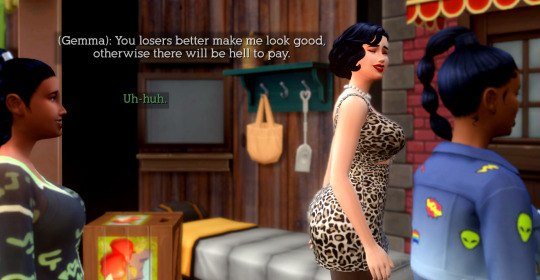

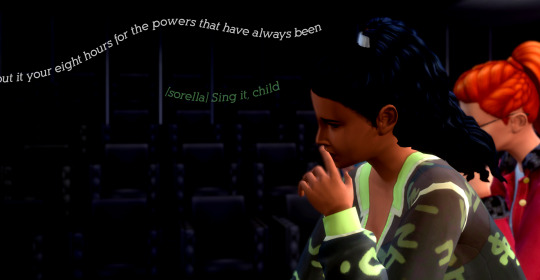


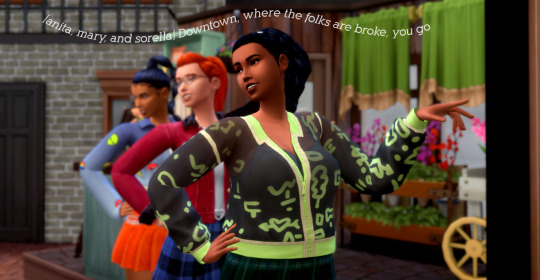

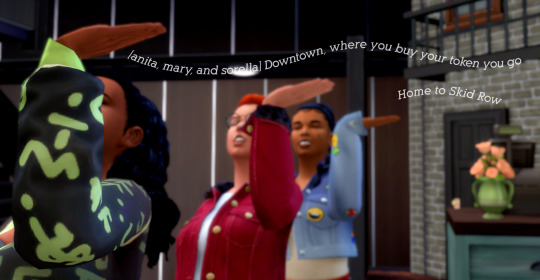

Gemma: You losers better make me look good, otherwise there will be hell to pay.
Sorella: Uh-huh.
-
Skid Row (Downtown)
[Anita]
Alarm goes off at seven, and you start uptown
You put in your eight hours for the powers that have always been...
[Sorella]
Sing it, child.
[Anita]
'Till it's five P.M.
[extra]
Then you go
[Anita, Mary, and Sorella]
Downtown, where the folks are broke, you go
Downtown, where your life's a joke, you go
Downtown, where you buy your token you go
Home to Skid Row
#simblr#ts4#ts4 legacy#sims 4#sims 4 legacy#cortes legacy#gen 4#sorella#anita#mary#gemma#mr. mortimer#in the ~film~ an extra starts this song.. but in the new broadway cast recording it's one of the trio#there's a fun fact for u#new broadway cast has kerry butler as audrey which i FAR prefer to the movie's ellen greene#(altho according to my sister ellen sounds better on the original broadway cast recording)#but i bounce between NBC and the movie's soundtracks#i like rick moranis as seymour better#kerry butler's somewhere that's green breaks me wee little heart#hi i went through a theater phase in may 2020 and that determined sorella's future#and im a bit of a nerd about it
14 notes
·
View notes
Text
Macavity the Mystery Cat (2019)
This analysis was a long time coming. I mean, it’s been a while since I’ve written one and I brought that up on Tumblr. After posing the question, a few mutuals said they were still interested in what I had to say. And here we are.
When I first heard Taylor Swift was cast as Bomablurina in the Cats 2019 film, I was very skeptical. I was going through a phase where I did not like Taylor Swift for some reason or another. I don’t know. Anyway, Like with Jason Derulo, I had to put my opinion aside to try my best to write an unbiased analysis. I didn’t even know Taylor Swift could sing Broadway or in that style. I’ll save my final comments about her performance and version of the song to the end like I usually do. So here we go.
Also, this ended up being 7 pages. The longest I have ever written for any of my analyses of this film.
Warning! The following is what I think and found in this particular scene. If you reblog and comment, please be respectful. Thank you.
Right at the start of the track, I was pleasantly surprised at what I heard the classic instrumentals for close to 10 seconds. This is then given a simple boost by an electric guitar, high hat, and piano which tells me and the audience this is going to be both familiar and new. This section also has what I like to call “Macavity’s theme” which is heard throughout the show on stage as well as in the film. But this is also 30 seconds of instrumentals to open this song. And we learn a lot about this version and the character singing it. It is suave, seductive with a bit of jazz to bring our attention to the who is singing. Speaking of seductive, Swift uses a breathy style of singing (if that makes any sense) to enforce this style of music.
Great touch there.
This is where I pretty much zone out. But for a good reason. I couldn’t stop listening because of how this is sung as well as the musical arrangement.
Then we get to about 1:32ish into the song and I think this is normally where the second character would start(?) but you can tell that there is at least a change in scenery due to how the brass do a “BAM!” type sound. This is a great idea since there is only one character singing.
The following is great instrumentation and another great example where the music is a character in itself. It’s very reminiscent of the stage version but it’s given an extra oomph much like the other songs in the film.
But then we get to what I think is another transition in the movie that doesn’t correlate to the track. This is around the 2:00 mark. She goes really quiet giving us a nice decrescendo but then we get sudden noise. It’s like she’s yelling at the camera or microphone which sounds off. However I can see the purpose in this in the next phrase and part of the song but as a listener, it made me uncomfortable.
We then hear a sharp noise when she sings the word “like”. This could mean many things such as telling us to listen to her. But it is an odd choice to have in this type of recording.
I still need to give kudos to the instrumentation because it sounds like a character in itself that improves upon what the artist is singing about.
Back to the song. We hear more about this cat called Macavity by this unknown female cat. She keeps repeating the same thing. He is a bad cat and has done some terrible things. However, this is constantly curbed by the fact it sounds like she is talking to herself rather than an audience. This is especially evident in a question/answer part of the song where she has a back and forth with herself. The speaker is constantly out of breath (though only in this section) and one can hear where there is supposed to be another person in the question/answer section. For those who want a reference, this is from 2:33-3:23. This is a huge chunk of the song.
But right after, we get to a section where other characters join in for a huge finale. The band goes all out with the horns, percussion, and strings creating an atmosphere of immersing the audience in the setting.
However, as I kept listening, I noticed that the character became out of sync with the chorus which took me out of the experience. But the character’s voice brought me back in when they sang by themselves.
The last fourth of the song is where it gets interesting.
The character is once again singing by herself, but she lists other cats who are agents of Macavity. Two of which we have met earlier in the story. But we still don’t know what her name is.
At 4:13 we get a new voice of a male character with whom we can only assume is Macavity himself. This is interesting since we have heard so much about him and he suddenly appears.
He then joins in to sing with the other cats and the one who’s been singing all along. This is an interesting choice and adds to the story of this specific song as given to us.
I do like how the music goes all out once again, highlighting the musical themes while also creating something new.
A great example of this is right after Macavity introduces himself. We hear an electric guitar. This creates and reminds us that this is something new.
However, the ending is a giant compilation of the song itself. It’s over the top. It’s bombastic. It’s telling us that even though Macavity is a dangerous creature, he also is an over-the-top showman who wants attention and wants something but we don’t know what.
Now onto the scene itself. In the film, this takes place immediately after Skimbleshanks is catnapped.
This scene takes full advantage of the old theater aesthetic. From the painted clouds to the crescent moon. The first shot is beautiful with (again) the painted clouds and a spotlight highlighting the interruption. The spotlight especially showcases the shadow of the crescent moon and because of the ceiling being the way it is, the audience can’t tell who is on it. All of which brings the mystery even further.
If you look closely, the clouds move downward as the moon piece does. We also get a quick look at the Misto, Victoria, and the rest of the Jellicles who have a constant look of curiosity. Victoria is more so than the others which tells us that they might know who this is.
The first glimpse of the crescent moon tells us three things. First, the moon prop is glittery, has stripes, and lights meaning it is over the top. Second, the cat on the said prop is a queen wearing heeled shoes. And third, they are holding something.
The camera gives us another quick shot of the Jellicles, but this time it’s of Old Deuteronomy and Munkustrap.
When the camera is brought back to the cat on the moon, we can see more of the shoes and the object they are holding. The shoes are very reminiscent of the showgirl shows of the 1930s which is period-accurate since the film takes place in the 1930s. The object looks to be a miniature shaker of some sort that has red, silver, and gold rhinestones as well as the word CATNIP on it in silver rhinestones.
This tells us that this is going to be a show whether we like it or not.
Then we get a shoe of everyone looking up and the camera shows Mungojerrie and Rumpleteazer holding the same bottles as the guest. Rumpleteazer is looking down as if she is looking at the rest of the Jelllicles while Mungojerrie is looking up at the sudden guest.
Right away when the guest sings, her tail keeps in time with the song which could mean various things but in this case, it means the animation is perfect for what we know about the character so far.
As the camera pans over the guest, we notice that she is settled into the moon and we get a great view of the set as well as the stage itself.
Now the guest taps some of the catnip powder onto the Jellicles which causes them to start acting odd. However, I don’t like what the camera does here or it might be because of the editing. It would have been better to stay on the Jellicles a bit longer to see the choreography the catnip makes them do rather than have a jump cut to the guest pouring more catnip. It would just make more sense from an audience point of view. They start doing choreography, but it stops because of that cut.
Back to the scene, we notice right away that this is not normal catnip. It is gold in color and has more severe effects than normal catnip.
In the next scene, we see Munkustrap encouraging Mistoffelees to take Victoria out of the theater. But the question is if he will succeed.
The guest then signals for Mungojerrie and Rumpleteazer to pour their catnip over the Jellicles. But on their cans, we get a quick shot of the 1930s style art of the catnip bottles. You can also see that these two are having fun with it all and not thinking of much else.
Then we get to the big moment where the guest pulls the lever with her hand and tail all while the moon prop is moving across the theater. We also get to see some of the mind-controlling effects of the catnip where the Jellicles are moving in sync with the music
Then there is a sudden jump cut to the guest, Mungo, and Teazer on the bar and the rest of the cats taking in the mind-controlling/magic catnip. There is a moment where Victoria (still not affected for some reason) is curious and it seems like the guest is trying to entrance the young cat with the words of the song rather than the catnip itself.
I do like the cut when the guest sings the line “his eyes are sunken in” because it shows more tail animation between the three on the bar from behind rather than the front.
We get more catnip effects.
Then comes a bit I find interesting. Usually, an actor tries to stay in the center of the frame since that's where most of the audience’s attention is going to be. Especially since the frame is normally in thirds. However, the guest goes from the center to the right third of the screen with Rumpleteazer AND wraps her tail around said queen’s neck and gets close. She does nothing to Mungoherrie who is now farther away.
Anyway, there is more sync dancing and Victoria is curious about what is happening.
Next, we get a jump cut that I hate. I understand that there needed to be something to show that the character needed to get from point a to point b. I get that. But the way it’s done makes it not only hard for my ears, but also what is she holding onto? If you track the shot, It should be bar to either moon prop or stool to ground. But instead, it’s bar to curved structure to the ground. The only clues we have are the light coming from the moon and Victoria’s gaze being upward. I am confused and the audience is probably confused too. Unless this is on purpose to make the viewer see this as an optical illusion but no I don't see that.
Back to the scene. After this, Munkustrap tries to dissuade Victoria from listening or even watching the guest.
I don’t have much to say for the next couple of seconds except that the dancing is really good.
Munkustrap finally gets hit with catnip from a third cat while victoria hides under the table.
The guest does her thing in trying to intimidate the last two cats trying to protect Old Deuteronomy (Maitre D and Cassandra)
I also just noticed that the guest’s entourage has bows on the backs of their collars and is pretty much in this scene to make sure the guest is the center of attention.
However, this is furthered from a ceiling shot where we see the spotlight on the guest which creates an interesting shadow on the floor of the theater.
She keeps singing and because of the way it is shot, we don’t see all the choreography that's being done. You cant see it. But we do have a quick scene showing how Munkustrap is out for the count while holding a glass. He has fallen under the catnip's effects. If you look closely you can still see Mistoffelees on the floor getting used to the same effects.
When we get back to the guest, she is still singing toward Old Deuteronomy while Victoria is still wondering what is going on. We also get a sense that the guest is trying to seduce either the audience or is creating a distraction. Either way, she is moving along with the music rather than just reacting to it. She uses it to her advantage.
With Victoria, we get a hit-or-miss moment. Even though she is in clear focus, we get a fuzzy movement from that other cat I mentioned before. It took me several times to notice it but it keeps the song moving forward story-wise because Victoria is still one of the few characters not under the catnip’s effects.
Then we come to another problem. After this, we come to a section that’s all choreography but we can't see it. We only get glimpses of it. Because of this, we don't get to see what the pairings are doing. We only get the spotlight on her. Which, while working for the scene, takes away from that part of the choreography. It would have been cooler if the camera was further out so you can get the effect of a circle or something like that.
Then there is Cassandra who jumps over Munkustrap to try to move Victoria from this danger once again which does not work. Cassandra falls for the distraction from the guest after being teased about failing to protect Old Deuteronomy.
When the guest is approaching Cassandra you can see in the background the other cat, Mungo, and Teazer being successful in dousing Victoria in catnip. Also if you look in the background at 3:33 you can see Mistoffelees still on the ground and not with the rest of the group. He has trouble moving and (right before the cut) looks like he is trying to reach out to stop the other cat. Then at 3:42 Munksutrap has some consciousness and it looks like he is trying to see if Victoria is okay.
But when the guest is on a new stage Victoria is front and center gazing at her. You can also see Tugger and Mistoffelees very clearly in this part. But right afterward Mistoffelees, Plato, and Socrates are given another dose of the catnip as if to reaffirm the effects once more.
And now we know the name of the third cat. Griddlebone seems to be an agent of Macavity.
And Mungojerrie finally gives Maitre D a dose of the catnip to take him out. Though it does look like he was about to say something, Mungojerrie had a mischievous grin so it was all a bit of fun.
Then we get the next line. But if you look behind her you can see a spotlight turn on right before Macavity shows his face. He announces himself and then transports himself to the floor.
The sequence is pretty good since it shows the relationship between him and the guest. I wouldn't say there’s tension but they know each other pretty well and know how to distract the Jellicles. The choreography adds to that relationship.
When the frame jumps from close to wide, we see a lot. Munkustrap is on the guest’s side with a wide stance yet is still under the control of the catnip. It’s as if even though he can’t control his body, he is ready to protect everyone. You can also clearly see Tugger in the back.
Then we get a reference to movie musicals and styles from the 1920s and 30s. The huge over-the-top staircase to the Heaviside layer. This styling was popular during this period due to the invention of sound in the film industry. It could also just be a reference to the way theater was during that period too.
Then, as they are walking up the stairs, we see a few things. Munkustrap looks like he is enjoying himself. Cassandra finally gets a dose. And the other cats look like they are having fun.
But this also gives us a better look at the set. You can see how run-down it is. The Egyptian cats on the walls. They scratched on the floor. And even how the outside lighting affects the reds, yellows, and blues of the inside.
Time for the overall thoughts!
Alright. When I first watched this scene, I didn’t know what to think since I was unsure if a duet could be successfully turned into a solo. The numbers before this didn't give much promise either since those were silly and not entertaining.
With that in mind, I believe it was successful. It was entertaining, gave us some story, and wasn’t that bad.
However, this song could still have been done the same way in a duet style. Let me explain. You can still have the character in the song still singing but add in other characters like Cassandra or even Demeter to fill in that other side of the duet. Because it is a solo, it makes the question/answer section very confusing to a new listener.
Now to Taylor Swift. I have nothing against Taylor Swift. I thought she did well, similar to Jason Derulo’s performance as Tugger. Her acting in this scene was better than I thought and her singing was like listening to one of her concerts. You can tell she was having a lot of fun bringing this character to the screen.
My only problem with this scene has nothing to do with the music, staging, acting, or choreography. It has to do with this simple fact that her character’s name is never mentioned once by another character. When I first began this analysis I posted a simple question on Tumblr. Is her name ever mentioned or stated? The answer was no.
Taylor Swift plays the character Bombalurina who (in the stage version and most non-replicas) never interacted with Macavity personally and is always by Demeter’s side during this song. But in this case, the only time her name is mentioned is in the very beginning during the “Naming of Cats”. This could have easily been solved if there was a simple line of dialogue in between the last number and this one.
I also believe the set added to the performance. It was huge, detailed, and the lighting created a sense that this was a performance that is necessary to watch and should not be skipped. The only problem with having a big space like this is that (like the Jellicle Ball) you can’t see a lot of the choreography because the camera is so focused on Swift’s character. There were some cool shots that I mentioned above but it was hard to see a lot of the dancing.
There were also a lot of background moments. From the constant need to protect Victoria to Mistoffelees and Munkustrap showing the audience the effects of the catnip.
Is this song terrible? I would have to say no. I would definitely listen to this one more than a couple of notable ones.
@uppastthejelliclemoon @storyweaverofgondor @roxycake
@thenightjillcamehome @imdumbandaproblem @bombaswife @jellicle-chants @falasta @queen-with-the-quill @indianasolo221 @gortys-and-loaderbot @falasta @cxsmicbrownies @hysperia
@skimblyshanks @scorpiofangirl1109
#FINALLY!!!#it has been written#it's been what 5 or 6 months since I've started this#but it is here#cats the musical#macavity the mystery cat#macavity 2019#cats 2019 analysis#cats 2019#taylor swift#Bombalurina 2019#please heed the bold text above and be nice#i dont actually like how i wrote the film part though
35 notes
·
View notes
Text
ROUGH ROAD TO TOP
August 16, 1953
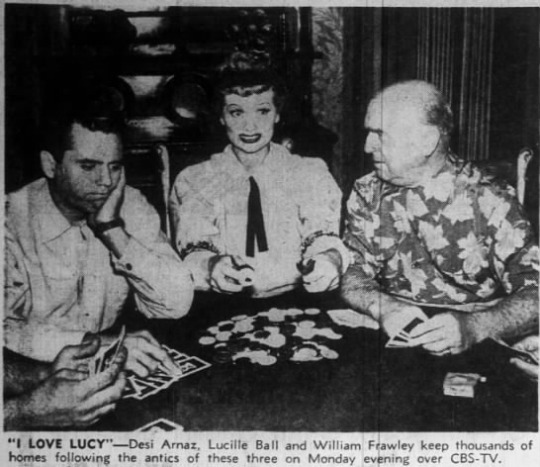
(1)

One of the more famous CBS-TV shows is “I Love Lucy.”
Its two chief characters - Lucille Ball and Desi Arnaz - have had a rocky road to their present status as one of the top comedy teams in the country.
At the end of Lucille's first year in dramatic school she was told by her teachers that she was wasting her time and money, that she would never become an actress. She was fired from all four of her first jobs as a chorus girl. Later, as a model, she almost lost her life in an automobile accident and was told she would never walk again.
Revolution Factor
It was a revolution in Cuba and a mishap in World War II which were fateful turns in Arnaz’ trip to stardom. The Cuban revolution destroyed his family’s wealth, drove them to the United States. World War II got him a broken kneecap in basic training, and since he had been a professional entertainer, he was placed in limited service and assigned to entertain hospitalized G.I.s'.
Columbia Pictures gave Lucille a contract as a stock player, and, convinced that her luck finally had turned, she sent for mother, grandfather, and sister to join her in California. But, the morning after she wired her family, the studio decided to dissolve its stock company. When the family arrived, Lucille was working as an extra at Paramount.
Bit parts and extra roles in a number of pictures kept Lucille busy, but not prosperous, until she was cast in ’"Roberta.” RKO officials, impressed by her work, gave her a contract. When not busy before the cameras, she was a mainstay of the studio's Little Theater. (2)
Offered Stage Lead
Her performance in the second lead in “The Girl from Paris" (3) drew Broadway's attention to Miss Ball and she was offered a lead in the musical "Hey Diddle Diddle.” After satisfying her yen to perform on the Great White Way (4), she returned to Hollywood for "Stage Door” and “Too Many Girls.” In the latter picture, she was costarred with Desi Arnaz. They were married Nov. 30 1940 in Greenwich, Conn.
Back from her honeymoon, Lucille walked into her first really big break a role in "The Big Street,” based on a story by Damon Runyon (5). Overnight it made her a star.
Her first assignment at M.G.M. in 1942 was the title role in the Technicolor production "Du Barry Was a Lady” (6). Stellar roles followed in "Best Foot Forward” and "Meet the People" (7). After completing "Easy to Wed” with Van Johnson (8), she headed for New York to be with her husband, then out of the army and on his way to success in the orchestra business.
Starred on Tour
Shortly after completing "Her Husband’s Affairs,” (9) Miss Ball went on tour as star of Elmer Rice's play "Dream Girl” (10) then worked with Sonny Tufts and Victor Mature in "Interference” for R.K.O. (11)
Lucille, Desi, arid their year-old daughter Lucy Desiree, live at Desilu, their five-acre ranch at Chatsworth, Calif. They raise cattle, chickens, dogs, and cats and dabble in farming. Enthusiastic fishermen they spend a lot of time on their boat.
Desiderio Alberto Arnaz y de Acha was born in Santiago, Cuba, son of the mayor. Desi’s mother, Dolores de Acha, was considered among the 10 most beautiful women In Latin America.
Three ranches totaling 100,000 acres, a palatial home in the city, a private island in Santiago Bay, speedboats, a fleet of motor cars, and a racing stable were all at the command of the youthful Desi during the pre-revolutionary days. His father, after eight years as mayor of Santiago, was made a member of the Cuban congress In 1932.
On Aug. 12, 1933, came the revolution. Congress was dissolved. Its members jailed. The Arnaz property was confiscated, the homes burned to the ground. In 24 hours everything was gone except $500 Desi's mother had hidden. Desi and mother fled to Miami, devoted the next six months to efforts to free Papa Arnaz. from prison. They were finally reunited in Florida.
For Desi, life in these United States for several years was hard but interesting: he worked at truck driving, train yard checking, taxi driving, bookkeeping, and, of all things, bird cage cleaning. Desi’s father managed to launch an importing business. It went broke when a shipment of fruit spoiled in transit.
Show business at this point finally caught up with Desi. His first job was playing guitar and singing with a seven-piece rhumba band at Miami’s Roney-Plaza Hotel (12). Xavier Cugat (13) spotted him, was impressed with this Cuban boy who was to be dubbed "The Tempo” by critics of modem music. After a year as featured vocalist with the Cugat band, Desi organized his own group of musicians and moved into the swank La Conga Café in Miami (14).
George Abbott's Broadway hit "Too Many Girls” (15) was Desi’s next step up the ladder, in 1939. He played a Cuban football player, one of the leads, and played tropical drums. RKO bought the film rights and signed Desi to play his stage role. When the shooting was over Desi married the leading lady, Lucille Ball.
He spent from Feb. 1943 to Nov. 1945 in the Army, after which he toured the nation with his band playing theaters, dances, night clubs. He hasn’t been without a band since. In 1948, Desi made the Columbia film "Holiday in Havana.” (16)
He made a vaudeville tour with Lucille Ball and that convinced them they’d do well as a husband-and-wife team on television. The tour inspired the CBS-TV show “I Love Lucy,” which has been highly rated since it started. (17)
Desi Arnaz’s personality is as vibrant as the music he makes. He is friendly, direct in manner, has flashing dark brown eyes and brown hair. He’s an avid fisherman, rides and swims expertly: his tennis is the envy of his San Fernando Valley neighbors, Sue and Alan Ladd, Francis Lederer, Jackie Oakie, and the Andrews Sisters. (18) A good cook, he specializes in such tempting dishes as Ginger Beef and Bouillabaisse.
# # #
FOOTNOTES FROM THE FUTURE

(1) The photo is from “Be a Pal” (ILL S1;E2) aired on October 22, 1951, nearly two years earlier. There’s one thing missing from this file photo: Vivian Vance. The success of the show was its foursome, not threesome! If you look closely you can see the hands of the other poker players, Richard Reeves (Hank, left) and Tony Michaels (Charlie, right).
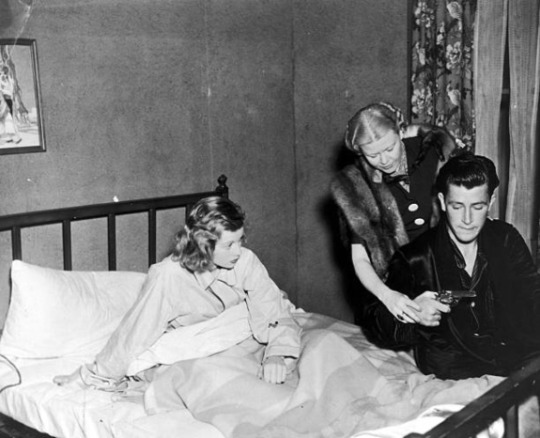
(2) Lucille did several plays at the RKO Little Theatre under the direction of Lela Rogers (above), Ginger’s mom. When Lucille later bought RKO, she dubbed it the Desilu Playhouse, a training ground for new young performers, often hand selected by Ball herself.
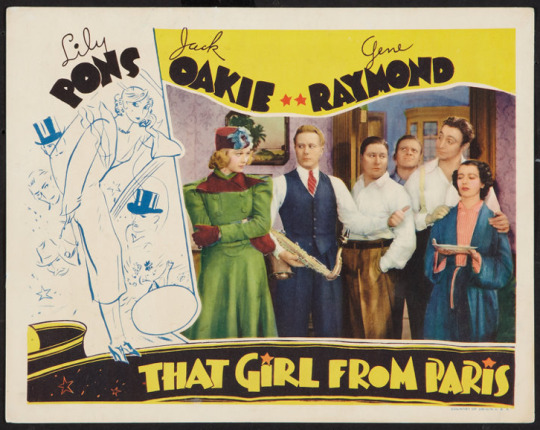
(3) “That Girl from Paris” (not “The” as the article states) was Lucille’s 33rd film. The light-hearted musical romance earned an Oscar nomination for Sound Recording. It was released on the first day of 1937.
(4) Lucille was indeed cast in the Broadway-bound comedy (it was not a musical, however) “Hey Diddle Diddle!” It opened in Princeton, New Jersey, the first of several out-of-town stops on the way to Broadway. What Lucille’s publicity omits is that the show never got further than Washington DC due to the serious illness of its leading man, Conway Tearle. So Lucy’s Broadway debut would have to wait - until 1960!
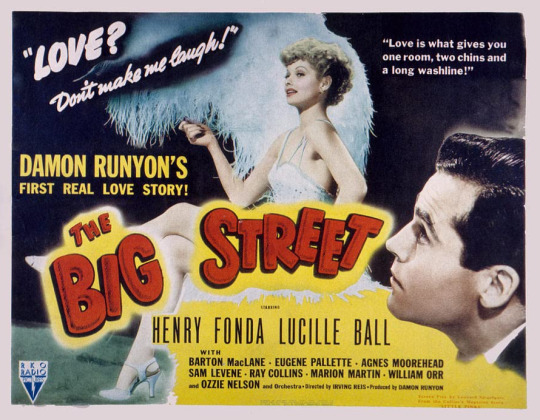
(5) “The Big Street” opened on September 4, 1942. It was based on a Damon Runyan short story about a night club singer (Lucille) embittered by an accident that left her in a wheelchair and her romance with a naïve admirer (Henry Fonda) named Pinks. Lucy later said it was her favorite of the many films she made. It was her 55th film.
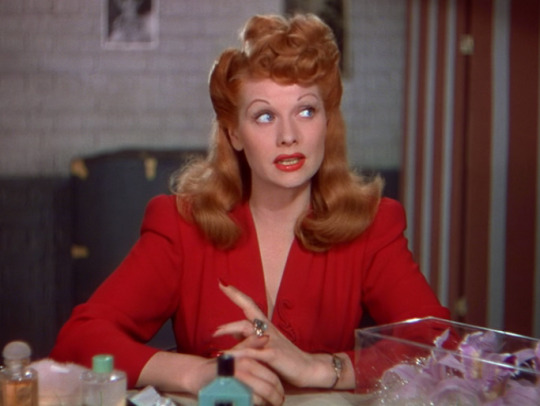
(6) “Du Barry Was A Lady” premiered in August 1943. It was Lucille’s 57th film, but her first for MGM. She nabbed the role from her friend Ethel Merman, who had done the Cole Porter musical comedy on Broadway. It was filmed in color, and was the film that earned her the nickname “Technicolor Tessie” because of her bright orange hair - a color she committed to from then on, despite her roots! This is the film that introduced Lucy to the song “Friendship”, which she would also sing on “I Love Lucy.”
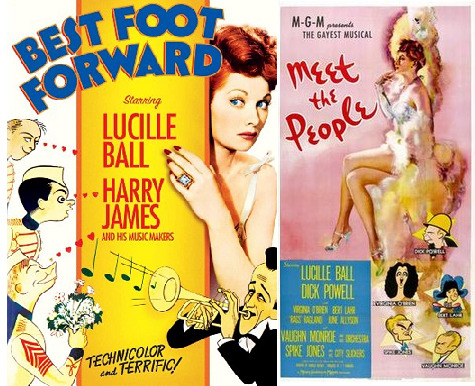
(7) In the musical comedy “Best Foot Forward” (1943) Lucille Ball played herself. It was her 58th film. “Meet The People” (1944) was a romantic comedy for MGM, Ball’s 60th film.
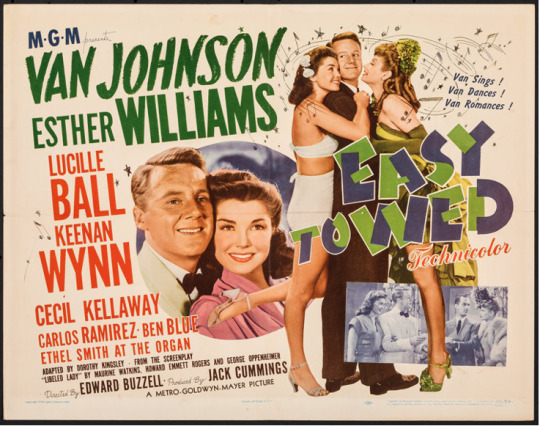
(8) In 1946 she released her 63rd film, “Easy To Wed” co-starring Van Johnson and Esther Williams. Lucille and Van had appeared together in “Too Many Girls” and he would appear on Lucy’s television shows.
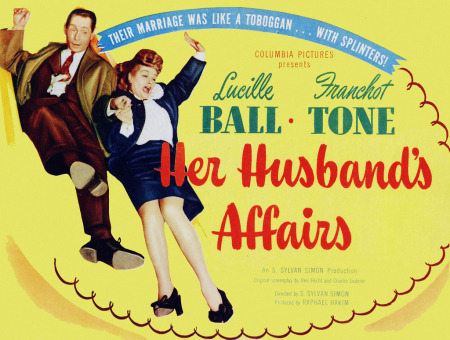
(9) “Her Husband’s Affairs” (1947) was a romantic farce with Lucy teamed with Franchot Tone. It was her 69th film.

(10) Back to the stage, Lucille accepted the leading role in a revival tour of “Dream Girl” a fantasy comedy by Elmer Rice. Once again, the play launched in Princeton, but this time Broadway was not the goal. It had already played the Great White Way two years earlier. The play toured the country at select cities, landing Lucille back in California in late 1947. In one SoCal gig she was appearing simultaneously with Desi and his band just a few blocks away. No doubt this was by design.

(11) RKO’s “Interference” was re-named “Easy Living” (1949) and dealt with the world of professional sports, namely football. It co-starred Victor Mature and Sonny Tufts. It was Ball’s 71st film.

(12) The luxurious Roney Plaza Hotel in Miami Beach was located on the corner of Collins Avenue and 23rd Street. It opened in 1925 and was demolished in 1968. The resort attracted a who's who that included Hollywood stars and even the Duke and Duchess of Windsor. The hotel's Bamboo Room & Restaurant was the place to be seen on the Beach for decades.
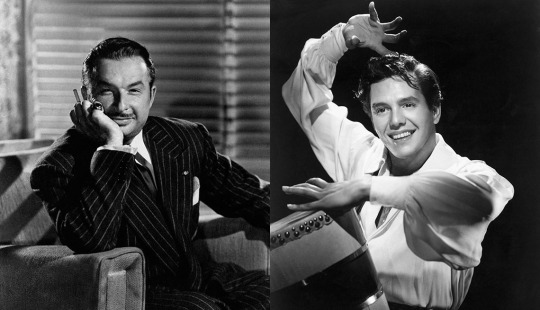
(13) Xaviar Cugat (1900-1990) was a Spanish musician and bandleader who spent his formative years in Havana, Cuba. A trained violinist and arranger, he was a leading figure in the spread of Latin music. In New York City he was the leader of the resident orchestra at the Waldorf–Astoria before and after World War II. He was a mentor and friend to Desi Arnaz, who kept his name before the public by making him a rival of Ricky Ricardo on “I Love Lucy” where his name became a punchline. In reality, Desi was grateful to Cugat, not jealous of him!
“I learned a lot from Xavier Cugat” ~ Desi Arnaz

(14) La Conga Café was located in New York City, not Miami, although the article may be referring to a different, lesser known establishment where Desi Arnaz performed. He became a regular headliner at La Conga, even issuing a record titled “La Conga” in 1939.

(15) Speaking of 1939 New York, Desi appeared in his only Broadway show in 1939, Rogers and Hart’s “Too Many Girls.” When the film rights were purchased by RKO, Desi was hired by director George Abbott to recreate his role. It was while filming this movie that he met Lucille Ball.

(16) “Holiday in Havana” was a Columbia picture released in October 1949. The film is about a Cuban hotel busboy (Arnaz) who dreams of becoming a composer. His love interest was not Lucy, but Mary Hatcher.

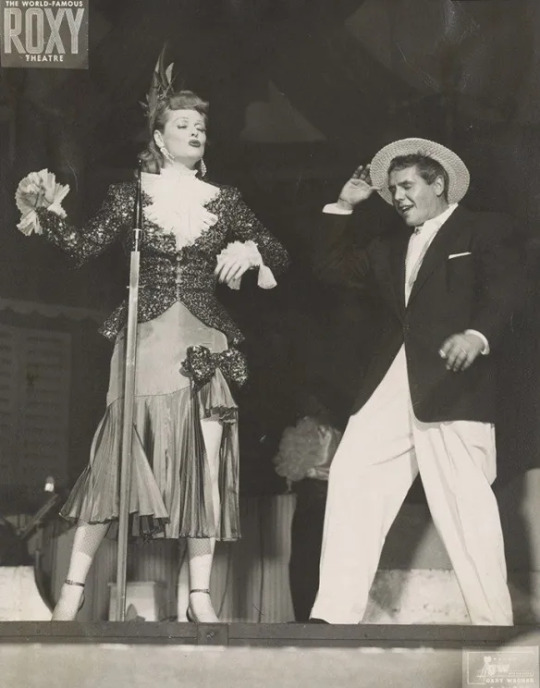
(17) The Tour incorporated some of the same routines seen in the “I Love Lucy” pilot as well as early episodes of the series, most notably the “Cuban Pete / Sally Sweet” duet. The tour culminated at the Roxy in New York City, where Desi was playing when he married Lucille in 1940.

(18) Before moving to their Beverly Hills mansion, Lucy and Desi lived on a ranch in Chatsworth in San Fernando Valley. They dubbed their ranch home Desilu. About their neighbors:
Alan Ladd (1913-64) was a chorus boy when Lucille was an Earl Carroll showgirl in Murder at the Vanities (1934). He was married to Sue Carol (1906-82) from 1942 until his death. Carol’s name was mentioned on “I Love Lucy” in “The Fashion Show” when Lucy selects the same Don Loper original that Carol has chosen to wear in the fashion show. She does not appear on screen.
Francis Lederer (1899-2000) was a Hungarian-born actor. In 1960 he did an episode of Desilu’s “The Untouchables”. From 1941 until his death he was married to Marion Irvine.
Jackie Oakie (1903-78) did four films with Lucille Ball between 1934 and 1938, including both “Annabell” movies.
The Andrews Sisters were the pre-eliminant close-harmony girl group of their time. The consisted of Patty, Maxine, and LaVerne. They were mentioned on “I Love Lucy” in “Be a Pal” in the same scene that the photo at the top of the article came from. In 1969, Patty Andrews guest-starred as herself on “Here’s Lucy”. Lucy and Lucie played the other two Andrews sisters.
13 notes
·
View notes
Photo


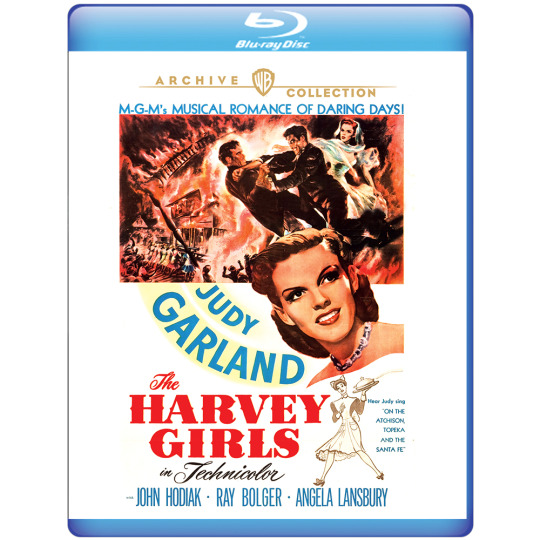
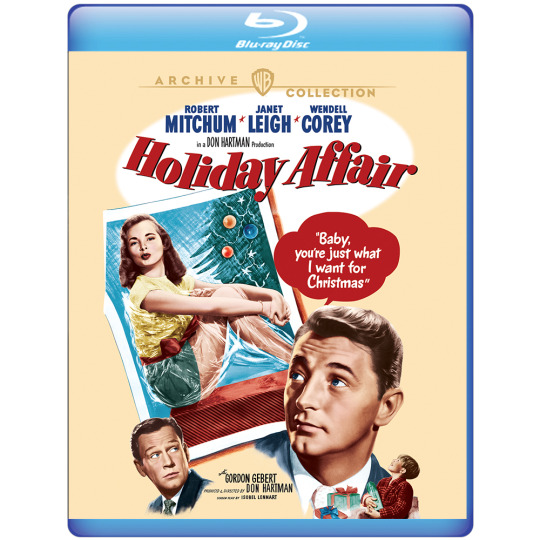
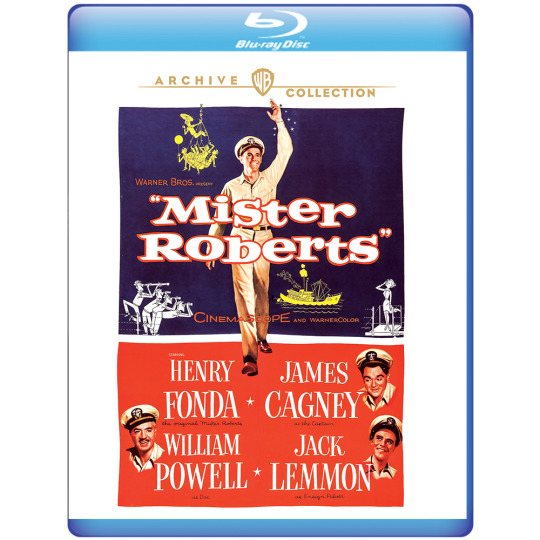
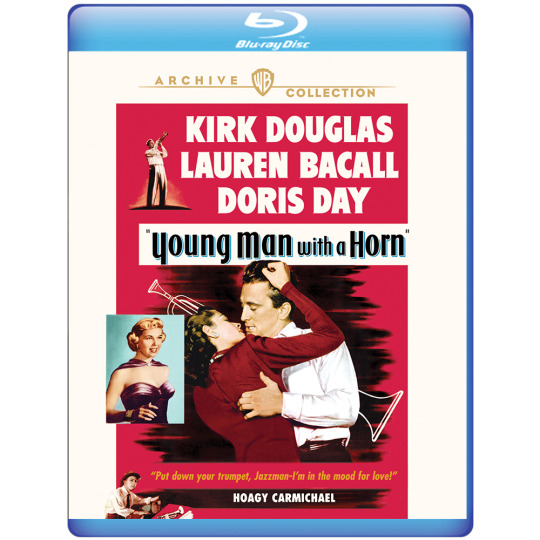
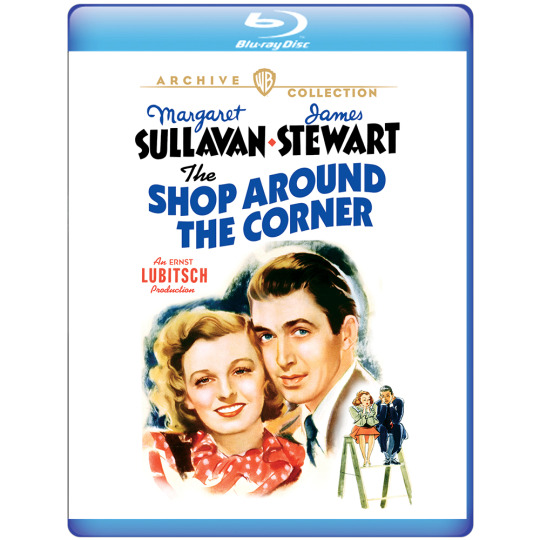
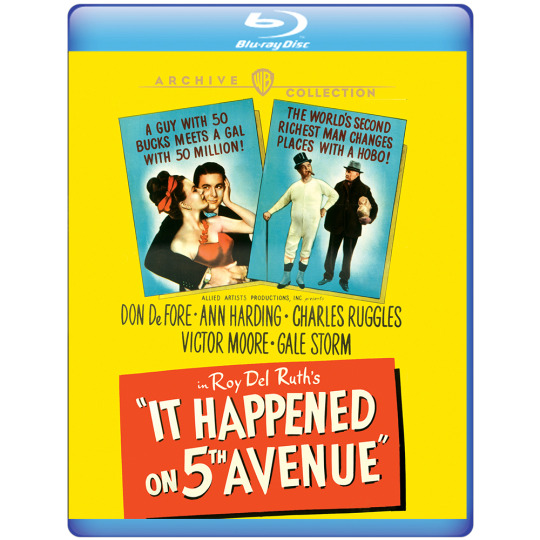

DECEMBER 2020 RELEASES - Coming soon to Warner Archive!
TEX AVERY SCREWBALL CLASSICS - VOLUME 2
New 2020 1080p HD Masters from 4k Scans of Preservation Elements
Run Time: 149:00
Subtitles: English SDH
Audio Specs: DTS HD-Master Audio 2.0 - English
Aspect Ratio: 4x3, 1.37:1 Full Frame
Product Color: COLOR
Disc Configuration: BD 50
Special Feature: Documentary "Tex Avery: King of Cartoons"
Welcome back for another three-ring circus of animated comedy from the legendary leader of cartoon fun – director Tex Avery. In the first ring, Avery serves up some of his finest one-shot creations: cartoons featuring cats who hate people, wacky cuckoo clocks, kooky cavemen and lovelorn French fleas. We also meet up again with Avery's attractive Red Riding Hood, a pair of amorous wolves and his durable all-around fall guy, Spike. The second ring is a showcase for Avery's ironically deadpan "Happy Hound": Droopy. This time, Droopy appears in a number of guises – each one funnier than the last. As bandleader "John Pettybone," he leads his jazz-playing fleas to the heights of canine stardom. Out West, as a homesteader and a sheepherder, he has his final showdowns with the Wolf. The third ring offers a whimsical glimpse into the future – or at least a future from the POV of the mid-20th century – with a plethora of zany postwar inventions. While none of the cartoons "of tomorrow" foresaw smartphones or Blu-ray players, these far-fetched contraptions, gadgets, houses and farms, televisions, and various modes of transportation could only come from the madcap mind of Avery and his MGM crew. Uncut, restored and remastered in High Definition for the first time, Tex Avery Screwball Classics Collection Volume 2 is another must-own collection from the master of hand-drawn mayhem.
This 21 cartoon collection includes:
1 LITTLE RURAL RIDING HOOD
2 THE CUCKOO CLOCK
3 MAGICAL MAESTRO
4 ONE CAB'S FAMILY
5 CAT THAT HATED PEOPLE
6 DOGGONE TIRED
7 THE FLEA CIRCUS
8 FIELD AND SCREAM
9 THE FIRST BAD MAN
10 OUT FOXED
11 DROOPY'S DOUBLE TROUBLE
12 THREE LITTLE PUPS
13 DRAGALONG DROOPY
14 HOMESTEADER DROOPY
15 DIXIELAND DROOPY
16 COUNTERFEIT CAT
17 VENTRILOQUIST CAT
18 HOUSE OF TOMORROW
19 CAR OF TOMORROW
20 TV OF TOMORROW
21 FARM OF TOMORROW
THE CURSE OF FRANKENSTEIN (1957) - 2 DISC SPECIAL EDITION
New 2020 1080p HD Restoration Masters from 4K Scans of Preservation Separation Elements
Run Time: 83:00
Subtitles: English SDH
Audio Specs: DTS HD-Master Audio 2.0 - English
Aspect Ratio: Disc One-1.85:1-16x9 Widescreen and 1.66:1-16x9 Widescreen
Product Color: COLOR
Disc Configuration: 2-BD 50
Special Features: New feature commentary by Screenwriter/Film Historian Steve Haberman and Filmmaker/Film Historian Constantine Nasr, Newly Remastered 1.37:1 Open Matte version of feature. New Featurettes include: The Resurrection Men: Hammer, Frankenstein and the Rebirth of the Horror Film, Hideous Progeny: The Curse of Frankenstein and the English Gothic Tradition, Torrents of Light: The Art of Jack Asher, Diabolus in Musica: James Bernard and the Sound of Hammer Horror, Original Theatrical Trailer (HD)
The first, and perhaps the best of the long-running series of horror films from the house of Hammer, Peter Cushing and Christopher Lee star in this landmark interpretation based on the famous Mary Shelley story. Baron Victor Frankenstein becomes friends with one of his teachers, Paul Krempe. At first, both men are fascinated by the potential of their re-animating experiments. Eventually, though, Krempe refuses to help with Frankenstein's human experiments. However, he is drawn back into the plot when Frankenstein's creature kills a member of the house staff. For its U.S. Blu-ray debut, Warner Archive is proud to present this deluxe 2 Disc Special Edition, featuring two theatrical aspect ratio presentations, meticulously remastered and restored from preservation separations, as well as bonus disc with the restoration presented in "open-matte" format, as was seen for years on television, plus four exciting new retrospective featurettes, an expert commentary, and the original theatrical trailer.
THE HARVEY GIRLS (1946)
New 2020 1080p HD Restoration from 4K Scan of the Original Nitrate Technicolor Negatives
Run Time: 102:00
Subtitles: English SDH
Audio Specs: DTS HD-Master Audio 2.0 - English
Aspect Ratio: 1.37:1 4x3 Full Frame
Product Color: COLOR
Disc Configuration: BD 50
Special Features: Feature-length audio commentary by Director George Sidney, Three Deleted Musical sequences: March of the Doagies, March of the Doagies (reprise), and My Intuition. Scoring stage sessions (audio only) featuring pre-recordings made for the film including the unused "Hayride". "On the Atchison, Topeka and the Santa Fe" Remixed in Stereo (HD), Original Theatrical Trailer (HD).
Judy Garland headlines The Harvey Girls, a joyous slice of Americana celebrating the "Harvey House" restaurants that brought extra helpings of civilization to the Old West. Famed M-G-M musical producer Arthur Freed brought together an impressive cast of talents for this box-office hit which features a delightful original score by composer Harry Warren and lyricist Johnny Mercer, who earned an Oscar for their On the Atchison, Topeka, and the Santa Fe as the Best Song of 1946. Garland once again shares the screen with her "Oz" co-star Ray Bolger, clowns with Virginia O'Brien, falls in love with leading man John Hodiak, and faces off against wicked saloon gal Angela Lansbury in one of the most entertaining and enduring musical classics to come from Metro's golden age, now fully restored to its original Technicolor luster for its Blu-ray debut.
HOLIDAY AFFAIR (1949)
New 2020 1080p HD Master
Run Time: 87:00
Subtitles: English SDH
Audio Specs: DTS HD-Master Audio 2.0 - English
Aspect Ratio: 1.37:1, 4x3 Full Frame
Product Color: B&W
Disc Configuration BD 25
Special Feature: Lux Radio Theater broadcast (12/18/50) with Robert Mitchum and Laraine Day, Original Theatrical Trailer
RKO's resident "bad boy" Robert Mitchum (Out of the Past) surprised audiences with his softer side in this classic Yule-themed romantic comedy. Mitchum portrays Steve Mason, a department-store clerk who loses his job, yet buys an electric train set for a child he scarcely knows. It must be Christmastime. Robert Mitchum and Janet Leigh are warmly matched in Holiday Affair, a seasonal favorite scripted by Isobel Lennart (later to adapt Mitchum's The Sundowners) and directed by Hope/Crosby "road movies" veteran Don Hartman.
MISTER ROBERTS (1955)
New 2020 1080p HD Remaster from 4K Scan of Original Negative
Run Time: 121:00
Subtitles: English SDH
Audio Specs: DTS HD-Master Audio 5.1 – English
Aspect Ratio: 2.55:1-16x9 LETTERBOX
Product Color: COLOR
Disc Configuration: BD 50
Special Features: Commentary by Jack Lemmon, Original Theatrical Trailer (HD)
The USS Reluctant carries cargo along World War II's forgotten Pacific seaways. Beyond the horizon, the real war passes its stir-crazy crew by. Mister Roberts, directed by John Ford and Mervyn LeRoy, is the classic story of men fighting to survive – not war's dangers, but its indignities. Henry Fonda's reprise of his Tony®-winning Broadway role returned him to movies after seven years away. Jack Lemmon won his first Academy Award® as hapless, lecherous Ensign Pulver. James Cagney's petty, scrappy Captain makes a fierce adversary. In his final film, William Powell makes world-weary Doc a sage for the ages. Mister Roberts has moments of unforgettable humor. But sadness tempers the comedy. No shot is fired. No blood is spilled. Yet Mister Roberts endures as one of our most truthful war sagas.
YOUNG MAN WITH A HORN (1950)
New 2020 1080p HD Remaster from 4K Scan of Original Nitrate Elements
Run Time: 112:00
Subtitles: English SDH
Audio Specs: DTS HD-Master Audio 2.0 – English
Aspect Ratio: 1.37:1 4x3 Full Frame
Product Color: B&W
Disc Configuration: BD 50
Special Features: Lux Radio Theater broadcast (3/3/52) with Kirk Douglas and Jo Stafford; Vintage WB Cartoons: HILLBLLY HARE (HD); HOMELESS HARE (HD) and HURDY GURDY HARE (HD); Original Theatrical Trailer (HD)
With a secondhand trumpet and the loving guidance of a brilliant bluesman, a lonely boy grows into manhood as a superb musician whose talent carries him from honky-tonks to posh supper clubs. But his desperate search for an elusive high note – trapped in his mind but impossible to play – starts him on a boozy downward slide. Charged with dynamic performances by Kirk Douglas (the title role), Doris Day, Lauren Bacall and Hoagy Carmichael, and pitch-perfect direction by Michael Curtiz (Casablanca), the film is a feast of hot, cool, moody jazz. Legendary Harry James dubbed Douglas' hornwork. Day brings another fine instrument – her voice – to four standards. Movie and music lovers will be glad to meet this Man.
THE SHOP AROUND THE CORNER (1940)
New 2020 1080p HD Remaster
Run Time: 99:00
Subtitles: English SDH
Audio Specs: DTS HD-Master Audio 2.0 – English
Aspect Ratio: 1.37:1. 4x3 Full Frame
Product Color: B&W
Disc Configuration: BD 50
Special Features: Vintage MGM promotional film: "The Miracle Of Sound"; Screen Guild Theater radio broadcast (9/29/40) with Margaret Sullavan, James Stewart and Frank Morgan; Lux Radio Theater broadcast (6/23/41) with Claudette Colbert and Don Ameche.
Ernst Lubitsch adds his unique style of directorial aplomb to this timeless love story that marked the third of Margaret Sullavan and James Stewart's four film appearances together. A 1936 play by Nikolaus Laszlo called "Perfumerie" was the basis for this timeless love story set in a Budapest shop. With a witty screenplay adaptation by Samson Raphaelson, Stewart and Sullavan play bickering gift-shop workers Alfred and Klara, unaware that they have fallen in love with each other as secret pen pals who only know their respective correspondents as "Dear Friend". The charm of the stars ably supported by a sterling supporting cast headed by Frank Morgan make this timeless classic one to enjoy over and over again. The story was later filmed as "In The Good Old Summertime" with Judy Garland and Van Johnson in 1949, and as "You've Got Mail" in 1998. It was also the basis of the 1963 Broadway musical favorite "She Loves Me". Beautifully remastered from protection film elements made right from the original nitrate negative, this new Blu-ray presentation of the original 1940 classic is a joy to behold
IT HAPPENED ON 5TH AVENUE (1947)
New 2020 1080p HD Remaster from 4K Scan of Best Surviving Nitrate Elements
Run Time: 115:00
Subtitles: English SDH
Audio Specs: DTS HD-Master Audio 2.0 – English
Aspect Ratio: 1.37:1. 4x3 Full Frame
Product Color: B&W
Disc Configuration: BD 50
Special Feature: Lux Radio Theater Broadcast (5/19/1947)
As he does every winter, hobo Aloysius T. McKeever (Victor Moore) moves in to a mansion on New York City's 5th Avenue while its owners are away for the winter and invites all his hobo friends in from the cold. But this Christmas, Mary O'Connor (Ann Harding) comes home unexpectedly after a quarrel with her boyfriend to find her house occupied by jovial street dwellers. To make matters even worse, her father (Charles Ruggles) disguises himself as a hobo to get an invitation to stay in his own home -- and keeps his identity secret in this perennial Christmas favorite about rediscovering family and the joy of being together. Don DeFore (Romance on the High Seas) and Gale Storm (My Little Margie) co-star as the young love interests in this first release from Allied Artists Productions.
THE 100: THE SEVENTH AND FINAL SEASON (2020)
Run Time: 672 Minutes
Subtitles: English SDH
Audio Specs: TS HD-Master Audio 5.1 – English
Aspect Ratio: 1.78:1. 16x9 Widescreen
Product Color: COLOR
Disc Configuration: 3 BD 50
The seventh and final season opens with our heroes picking up the pieces of the society they destroyed on Sanctum. Still reeling from her mother's death, Clarke (series star Eliza Taylor), perhaps more than anyone, feels the toll of years upon years of fighting and loss. The group soon finds that maintaining order among the competing factions is no easy feat, and one that has them questioning whether their commitment to doing better was worth the price. At the same time, our heroes must contend with new obstacles on a scale beyond any that they previously experienced as they unravel the mysteries of the Anomaly. What they encounter on this epic journey pushes them to their limits both physically and emotionally, challenging their long-held conceptions of family, love, and sacrifice. Ultimately, our heroes must answer for themselves what it means to truly live, and not just survive.
23 notes
·
View notes
Text
OG!Peter Vincent assorted headcanons, Part Five
He’s a very animated and energetic storyteller who would hold the room rapt for as long as he’s willing to talk. And shame on Charley and Alex for ever getting bored with them because he tends to echo the mood of his audience–if they’re having trouble focusing, he’ll have trouble focusing and eventually wind down into a more easygoing and reflective mood. Peter’s never angry with people who aren’t as willing to listen, mostly because he gets so involved with his own tales that he’s instantly in an unshakably better mood.
Hosting movies with werewolves in them or vampire movies with wolf transformation scenes became a lot harder for him after everything that happened with Evil Ed and Jerry Dandridge, and it’s hard for him not to have small panic attacks between bumpers. To help comfort himself and make himself feel better about the viewing audience, he’ll sneak in small reassurances to anybody out there going through the same thing.
Peter Vincent wears sock garters. It’s canon now.
Peter firmly believes he counts as one of the “worried well.” His relative privilege compared to most of the people he knows (how many of them used to make four figure salaries per movie for thirty years?) convinces him that he doesn’t need help as much as other people do, regardless of what else he goes through. Besides, the only actors he’s aware of who check into outpatient care of any kind eventually die from it (poor Bela Lugosi is the example that often comes to mind), and he’s much too proud for that; plus, the only reason he was ever admitted to a mental hospital was through a misunderstanding. Thus, he’s avoided any kind of counselling for years and keeps saying he doesn’t need it–he doesn’t have it nearly as bad as so many others do, so why should he waste their time?
Peter is on the low level of the autism spectrum—probably Asperger’s syndrome or something similar. The biggest tell is that it seriously affects his sensitivity to touch; certain textures are downright disgusting to him, which is a big part of the reason he’s such a terrible cook. He also must be handling something at all times; if he doesn’t have something in his hands to stim with, he will go and touch something just to help him feel more at ease. Having so many of his old props in his apartment is a godsend for that reason. Not only are they collectors’ items, but they also give something to play with and show off whenever he has visitors.
An irritated Peter tends to be very passive-aggressive and snippy with whoever’s putting him in a bad mood. He tries to maintain a proper filter and not say anything he might later regret, but he’s still going to make it very obvious through his body language (exaggerated affectation of whatever mood he’s “supposed” to be in, lots of eyerolls and dirty looks) that he’s not very pleased with you, and it’s best not to poke the bear lest he get truly angry and start snapping at whoever pisses him off next.
Peter likes to sing or hum as he’s cleaning his props. He doesn’t have the vocal range for a lot of his favorite songs, but be prepared to hear “Penny Lane” and “Blue Skies” a lot. And he does take requests if you decide to join him.
Nurkel was a stray who more or less happened upon him one day during the three years Peter spent estranged from Charley. The poor cat was cowered in the cold outside the studio headquarters, and the actor took pity on him and threw him a couple of pieces of egg roll from his dinner. From there, the cat insisted on following him everywhere, including across the set, much to Mel’s annoyance. Luckily, Peter was introducing 1934’s The Black Cat that night, so he picked up the cat and worked his presence into his segments of the show. And when the poor creature insisted on following him home in search of more food, he had no choice but to keep him, naming him Nurkel because he’s always liked odd, cutesy names for animals. He’s a very skittish cat who yowls and spits at the slightest interruption or intrusion and for whatever reason, ever since that first night, has only shown Peter affection in small doses. Most of the time, he just runs away or goes and finds something better to do. And he has a very particular spot on the couch that he refuses to give up without loud complaining. Peter’s not entirely sure why this is, but his most likely guess is that Nurkel came from an abusive home and isn’t quite sure how to handle being treated like an actual pet rather than as an accessory with four legs or something to just be kicked when he got in the way. In any case, he leaves Nurkel to his own devices most of the time and only resorts to cuddling when the poor cat is hurt or severely agitated.
Peter was always sort of an odd duck when it came to the Hollywood “scene”. On one hand, he was an extrovert who loved attending cast parties no matter where they were held, relished getting to promote his films and meet new people, and was an unfailing charmer to anyone he met. On the other hand, the Great Vampire Killer persona he was contractually locked into sometimes made it difficult to genuinely connect with people—he was always wondering whether or not they enjoyed the company of the character or the man beneath the character. So as the years went on, he became less and less interested in making public appearances “out of character” since he was convinced by then that the persona was all people were really interested in. That, and with the rumors of his sexuality forever circling, he felt he had to be careful interacting with certain people, and he came to resent that more and more. And not only did he feel very far removed from the world of celebrity relationships because of bowing to fan preference, but his distinctly nonsexual leanings made it that much harder to relate as he listened to his fellow actors talk about their dating conquests (his reactions ranged from “Okay, whatever” to “Why would anyone be aroused by that?”).
One of the greatest scandals of Peter’s career—more than the speculations around his sexuality when it came to young extras and his alleged flirtations with Hazel Court, both of which were proven to be falsehoods—was his sudden and messy divorce from a friend of the McHoolihee family. Miriam Callaghan’s marriage to Peter Vincent was purely one of his convenience: she was already a Scottish ex-patriot living in America, and he desperately needed a visa so he could continue making his films across the pond. And he tried to make it very clear to her that her utility to him, her kindness he felt the need to repay, and the relative security the marriage provided were the only reasons he stayed—to say nothing of the fact that if anyone were to find out he was married, after all the fuss made about him being a “confirmed bachelor” (with all the ugly connotations the phrase came with), he would be professionally ruined. Unfortunately, the message failed to completely sink in for Miriam—she had convinced herself that theirs was a genuine love match and never tired of trying to milk an affection and lustiness out of Peter that he just didn’t feel. The fact not only did Peter never consummate their marriage, but also refused to publically acknowledge it, annoyed her to no end, and almost a decade later, she decided to get revenge. At the premiere of Blood Feast on Broadway, in front of God and sundry, not to mention a mess of reporters trying to get a statement from the Great Vampire Killer, Miriam grabbed Peter by the lapels and kissed him. In the resulting media wildfire, which caused studios and fans alike to wonder if Peter had been lying to them all this time, she went on record spreading a number of venomous lies about the actor and declared her intention to divorce him. The court case that followed left him with nary a penny to his name, and Miriam disappeared with the settlement never to be heard from again. To this day, Peter still regards it as one of his greatest personal shames and blames himself a great deal for how it all turned out…. if he had only been clearer about his intentions and ended things sooner, none of it would ever have happened.
Peter still has both of the rings from the marriage and was planning on pawning them off, but he felt too guilty to go through with it. They’re in a box in his desk now, and he’s not even sure what to do with Miriam’s ring anymore. He would love to give it to someone he genuinely loves, but imagines that any partner he could find would be insulted to given a ring once worn by someone else.
4 notes
·
View notes
Photo
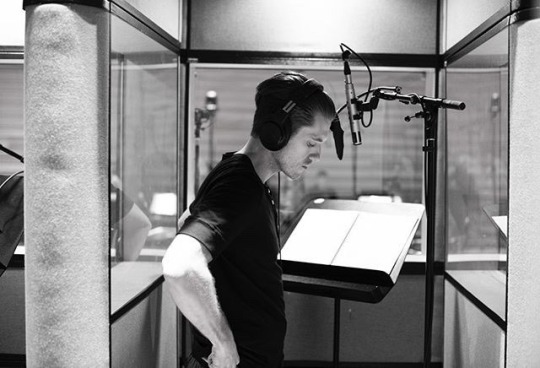




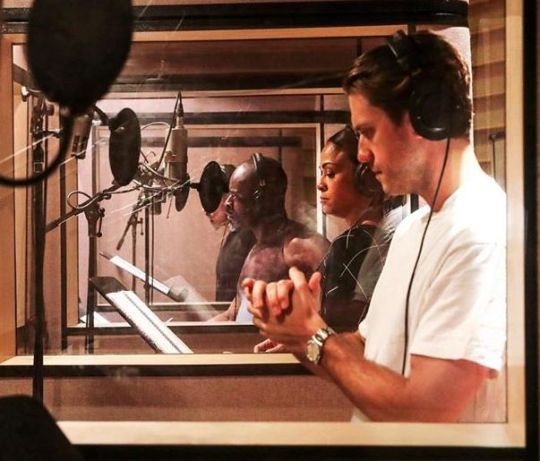
Baz Luhrmann's “Moulin Rouge!” Mega Mashup
Baz Luhrmann had swooped in to produce the cast album, which comes out this week. A monitor showed the actors Aaron Tveit and Karen Olivo, who were in side-by-side sound booths in the next room. Tveit and Olivo are the stars of “Moulin Rouge!,” a Broadway adaptation of Luhrmann’s 2001 movie musical, which pairs a Puccinian plot set in Belle Époque Paris with songs by Elton John, Madonna, and the Police, among others. It was one o’clock: time to record the big Act I duet, “Elephant Love Medley,” a mega mashup of some twenty pop songs, in which the bohemian-poet hero and his world-weary courtesan inamorata argue over the nature of love in her elephant-shaped dressing room.
Tveit recorded his first blast of dialogue: “But love is like oxygen to me! Love is a many-splendored thing! Love lifts us up where we belong!”
“Jolly her along,” Luhrmann advised over the mike.
When he and his writing partner, Craig Pearce, made the film, they envisioned a classic sparring-lovers-falling-in-love duet, like “I’ll Know,” from “Guys and Dolls. At first we did it with one song. Then we sliced it into two songs,” Luhrmann recalled. “And then came the idea: Well, what if he sang every great love song and she countered it?” Next came the arduous task of acquiring rights. “In those days, publishers wouldn’t give you a piece of a song next to another piece of a song, and so I had to physically connect with all the artists,” he said. “That’s how I met Elton.”
For the Broadway version, the show’s music supervisor, Justin Levine, revamped the medley. He started by brainstorming a list of thirty or forty love songs (“Take On Me,” “I Love You Always Forever”) and anti-love songs (“Love Hurts,” “Love Is a Battlefield”). Then he printed out all the lyrics and cut them up with scissors. Certain songs got discarded, either because they didn’t make sense dramatically or had rights issues (the Beatles allowed them to say, but not sing, “All you need is love”). When Luhrmann heard the new version, there were some songs he didn’t know, like Regina Spektor’s 2006 hit “Fidelity.”
In the studio, Luhrmann sat between Levine and Matt Stine, the show’s music producer, occasionally whispering to both. Before Take 14, Levine gave the actors some technical notes, asking Olivo to push the “don’t” in No Doubt’s “Don’t Speak,” and both to give more breath support to David Bowie’s “Heroes.” For the final flourish (“I Will Always Love You,” “Your Song”), he reminded them, “This is where we’re just so unapologetically in love with love. The song becomes a celebration. First it’s an argument, then it’s a repartee, then it gets a little sad, and then it’s a big explosion. Right?”
They belted it out a few times, to a recorded orchestral track. Luhrmann looked half pleased. “They can obviously sing it, but they’re not playing intentions strong enough,” he murmured to Stine. He spoke into his mike: “Can we play a silly little game? Do you think you can just sing a cappella going into the beginning? We’re not going to record it. Just play the actions. For fun.” Tveit and Olivo acted out the medley like a scene in drama class. Then Luhrmann told them, “Let’s go in, but don’t let the orchestra dictate it for you. You dictate it for the orchestra.” He added, “Convince each other.”
Take 18. Drumroll. This time, there was more zing in Tveit’s “Everlasting Love,” extra snarl in Olivo’s “What’s Love Got to Do With It.” By the time they were duetting on “Up Where We Belong,” it sounded as if they were singing the lines for the first time. Luhrmann smiled. “I, personally, think they nailed it,” he said. ♦
6 notes
·
View notes
Note
I have never watched Cats, I only know of it because of the trailer for the 1998 movie was in front of Barney's Great Adventure VHS so it's ingrained in my memory that way. (MEMORYYYYYYYYYYYYY, ok I love that song) For the most part I ain't got no issues with it. It's weird but I appreciate it. But girl. This trailer. This movie. It looks so weird. Why don't they have cat noses? Is anything even rendered? Why didn't they just do makeup? I'm so confused.
;alskjdf okay, one, I LOVE that you have memories from Barney VHSes like I do, because Barney was one of the biggest, non-Cats influences on my childhood. But I’M SORRY I’M GOING TO RANT ABOUT MY CATS FEELINGS RIGHT NOW OKAY
OKAY! So! The thing with me and Cats in general is that......my family moved to New York when I was 4, about an hour-ish from the City, and we lived there until like a month before I turned 7.
Anyways, I was fortunate enough to see plenty of Broadway shows as a kid, including my very first Broadway show, Cats. I loved it, I loved the animal and the musical, and was pretty obsessed with it. I saw it at least once more on stage, we owned the VHS of the taped show, which is how I learned the names of many of the “extras” (and we eventually got the DVD of it, of course). I got the book of the original poems (fun fact, “Memory” is one of two songs in the show that DOESN’T have lyrics by T. S. Eliot). I pretended to be the cats, even! My family all knows it very well from me and and my sisters (at least two of them) loving it from a young age. Two of our cats growing up were named “Grizabella” and “Rum Tum Tugger”, and those weren’t even the cats I named! Like, the musical was a huge part of my life as a kid. The “Now and Forever” ad music can still play in my head at a moment’s notice, and I was devastated when it closed because those ads promised me it would be there NOW AND FOREVER!! And, even years later, when The Phantom of the Opera first overtook it as the longest running musical (it’s now fourth under Phantom, The Lion King, and Chicago), I honestly was so displeased a;lsdkfjas
So, this musical has always hold this weird place in my heart, where I love it unironically but I’m also like aware that if I had seen it for the first time at a different age, I would’ve detested it. I still think there are some legit bops in it, and I get the urge every now and then to watch the recording - I can’t listen to the OBC or Original London Cast versions, though, because so many of the songs have gotten better and were altered from those version, particularly “Mungojerrie and Rumpelteazer”, god, the original versions are SO BAD compared to what it became, the whole reason why I want a brother and sister cat named after them.
So, they announce they’re doing this movie version and I’m already like.....very skeptical. Because why would they do a movie of one of the most made fun of shows of all time?
Then casting starts. First they just say Taylor’s in it, but won’t say who she is, same with James Corden. I assumed he’d be Bustopher, though, and assumed she’d be Bombalurina or one of the other more “narrating” cats, so, cool. Jennifer Hudson as Grizabella? Awesome. Ian McKellan? Idris Elba - in what’s supposed to be a non-singing or speaking role? Weird choice, but, okay. Professional ballerina for the silent ballerina role? Iconic! Hey, Jason Derulo had recently done something talking about his classical music training and sang something from Phantom and I was sold on him. Dame Judi Dench as a character called “he” who has “married nine wives”? Why not! It sounded like good casting and while I was just hoping they could, you know, basically film the stage production again or maybe do something animated if they really wanted to do this, I figured I’d give it a shot.
Then they said it was going to have CGI. And I knew it would be a hist show.
Then the trailer dropped a day earlier than planned and, clearly, I HAVE LOST MY MIND.
WHY ARE THE NOSES LIKE THAT? WHY DID THEY GO THIS WAY? WHY DID THEY HAVE TO KEEP THE BOOBS? WHY ARE THE CATS SMALLER THAN KNIVES WHEN THEY’RE SUPPOSED TO BE CAT-SIZED? WHY DID THEY DO JENNIFER HUDSON SO DIRTY IN HER LOOK??? WHY IS JASON DERULO THE ONLY ONE LOOKING PASSABLE???
Look, I knew this would be a mess from the get go. An adaption of this musical would always be a fucking mess. But this is, pun intended, a CAT-astrophe. Make-up would’ve been much better. Filming a semi-live version a la the other version would’ve been better. The camp of people writing around in leotards with heavy make-up and tails is part of what makes Cats, Cats! This is a huge, weird, uncanny valley, horrifying mess.
AND I AM LIVING FOR IT. Since day one, I have said "I can’t believe I’ll be seeing this opening day”, and by GOD am I fucking seeing it on opening day, come hell or high water. Opening weekend at the very least.
It’s going to be a shit show, but it’s my shit show. And I will watch it gladly.
(BTW Bombalurina is probably the role I’d want to play the most, partly because there are too many legendary versions of “Memory” to live up to, and she gets to sing “Grizabella the Glamor Cat” and the actual best song in the show, “Macavity”. So good on Taylor Swift, tbh.)
9 notes
·
View notes
Photo

MEET LILITH,
FULL NAME › Jacqueline “Lilith Adkins” Miller
AGE › twenty seven
GENDER › Cis woman (She/Her/Hers)
FROM › New York City, New York
LODGING › Silk Bonnet Hotel
PRIOR EMPLOYMENT › Actress
NOW PLAYING › Come Wander With Me by Bonnie Beecher
BIOGRAPHY,
trigger warnings: parental abandonment, emotional abuse/exploitation, substance abuse, brief mention of non-fatal overdose
“The only thing you’ve ever been good for,” Jacqueline’s mother used to say, “is zipping up my dress.” And, to Jacqueline, that seemed ever so true. A constant scapegoat for all of the worst parts of her mother’s life, it was gospel: “You’re the reason your father left.” “You’re the reason I can’t fit in my good dress anymore.” “You’re the reason we’re barely scraping by.” “You’re the reason for x, for y, and for z.” As the only constant in Jacqueline’s life, her mother certainly spoke nothing but the truth! Yes, yes – all Jacqueline would ever be good for were her genetics. Yes, yes – one day, she would be paying her bills using the money she received from pornography. Yes, yes – it was true! It had to be true!
Or, perhaps, there was another possibility for Jacqueline – a possibility her mother had not considered until the casting of an elementary/middle-school play. As with all elementary/middle-school plays of the day, it was no cut – it was, therefore, something to be brushed off when Jacqueline received the lead role… up until her mother witnessed the standing ovation she received, witnessed the secret talent she upheld. Ever the secret idealist, her mother took it as a sign.
She sent for various agencies, various managers, various anybodies-who-could-get-the-child-famous. It was originally a recording, originally a voice her mother exploited, but when the child’s new ego was born… oh, she could capitalize off of anything.
When an agency finally agreed to take her, there was one deal that needed to be struck: she was no longer ‘Jacqueline Miller.’ Nobody ever knew who Jacqueline Miller was. Nobody associated the name ‘Jacqueline’ with anything deeper than itself. Nobody thought ‘Jacqueline’ was the name of a big star. Nobody thought anything of ‘Jacqueline.’ Sure, there were Jackies to be associated with, but there was a different, much more unique name in mind: Lilith Adkins. It was for the shock value, you see – the shock value of a twelve-year-old becoming one of the most sinful characters of them all. As for the last name? Why, there simply had to be disconnect between herself and herself!
From there on out, it was a whirl-wind. Jacqueline – forgive me, Lilith – had not signed up for the life she was now being put through. She had not signed up for the surrounding of old men in suits at all hours of the day (some much stranger than others); she hadn’t longed to take amphetamines in the morning and barbiturates at night; she had never wanted to sit in a chair for four hours while strangers touched her face, then spend the next ten filming something that would be worth nothing… to her. To her mother, to the studio, to the agency – oh, it would be worth millions, quite possibly! – but, to her… nothing.
- She was always smiling, though. She was always getting good press throughout the discomfort of it all! -
However, with age brought tolerance, and tolerance brought taste. Sixteen and she had developed a taste for this lifestyle – a taste for some of these old men, for all of these strangers, for filming all day and all night. Perhaps it was because there were times she was not filming at all – she had hit New York City, she had hit Broadway. Cast alongside veterans, she received the blessing of playing a secondary role. While the pressure was still there, still looming, she was no longer the top-billed actress. It was a different lifestyle, that she was sure of, but nothing would ever become more different, yet stay so very similar, than it did when she earned the ability to drop her mother from any and all projects two years later.
It was now Arthur Sher, her agent, who was largely in charge of what she did and didn’t do. The flipside of it all was that she actually had input. She had a name now, a name all her own, a name not attached to her mother’s, a name not unknown, and that name would only be seen when and where she wanted it to be seen. She and Arthur ventured back to Los Angeles and time began slipping away. Why it slipped away, she could not say. He fed her so many scripts, so many she wanted her name on, that it became harder and harder to keep track of what day it was, where she was meant to be, what the time was, who she was supposed to be at that moment in time. Why, she got married and hardly remembered it.
For as stressed as she had become, juggling so many projects (albeit, by her own volition), the papers only ever said kind things about her. She was an actress, after all – she had acted in plenty of scenes that required feigned happiness. She was praised in the papers for doing so much and keeping it all together. She was praised for her marriage – apparently it had been expected for a long time, although she had never even thought of this man – this ‘George’ – as a boyfriend. She was praised for her patience with the paparazzi. She was praised for her generosity when she was seen giving a man on the side of the street a bottle of (half-drunk, mind you) water. Oh, she was praised!
So it can easily be said that it had started out perfectly innocent. She would take one pill, as needed, as per her psychiatrist’s instructions. But she began ‘needing’ them more and more, you see. Oh, but just taking a handful of pills was far too simple, wasn’t it? Of course, they always paired best with alcohol. Oh, and the nights her mother rang? Well, she just needed extra then! Oh, and the days she’d have to spend filming something for over ten hours? One, two, three, four, more! To say it had truly shocked Arthur that she had still managed to make it on set every day – on time and fully able to cooperate – was an understatement.
Of course, it was a shock for a reason! At home, things had not been quite as nice. She and George, this man she would now claim she loved (although she was not sure what that was at this point), had gotten into more than their fair share of wars with one another. She would accuse him of infidelity, he would point out the liquor and pills, she would say the latter was prescribed, he would say that maybe someone else was just what the doctor would prescribe for him. It all seemed very over-the-top and dramatic, all very hyperbolic and unrealistic, to Lilith… up until she came home late one night, hoping to make some form of amends, just to find George and another woman on their couch.
He was forced out that night. The couch was cleansed using alcohol and a lighter. She took some extra pills that night, then some more the next morning – I mean, why not? Then she began messing up the shoots. Then she took some more. Then she blamed the best boy, of all people, on why she was doing so horribly (he was distracting her!, so she’d claim). Then she would be let go from her projects, replaced with someone younger as a cycle began to repeat itself. Then the press would turn against her. Then she would overdose. Then she would be forced into rehab by Arthur. Then she would fight it. Then she would get sober. Then she would return to New York City.
There was a show on – a musical – that they figured she was best for. It was all but tailored for her – the songs in her range, the designs perfect for her. ‘Oh, Honey!’ was her grand reintroduction before she had even said yes… but publicity that required forgiveness and sympathy – there was nothing better. Now that opening night… it was impressive! It was almost as though Lilith wanted everyone to hate her, to leave her. Months of perfect rehearsal, months of friendly mingling with her co-stars and understudy, months of learning tragedies she’d missed and still powering through, months of avoiding pills and alcohol, months of perfect preparation and perfect sobriety… all to collapse the night the curtain was meant to go up.
You see, some weeks before, she had found a new psychiatrist, had gotten a ‘different’ medication! …but had made the ever-so-wise decision to abuse it that night. It was to calm her nerves!, she would lie – lie to herself. The second they knocked on the door to her dressing room, telling her the curtain was about to go up – the second she opened it to reveal she hadn’t changed outfits since she’d gotten there – that was the second they gave up on her. George had left her. Arthur left her. Her co-stars left her. She had left her mother. Every bridge she had built, she burned. All she had left was the world, and even they began praising her understudy, beginning to forget it was her name in big letters above the title.
She gave up that night. She gave up the first night. She didn’t have anyone or anything left. She had no reason to be there. She had no reason to be anywhere. So she drove. She took pills and drank liquor and drove, just like the clown she’d always been under that false identity of hers. She drove, high out of her mind, and did not die – was not pulled over… some sort of miracle, yes? She drove, high out of her mind, until she simply couldn’t anymore. She drove, high out of her mind, until she reached some small western town called Boot Hill. She had nowhere else to be. Maybe there, nobody would know her. Maybe there, she wouldn’t have to see what papers said about her (oh, she hoped they were asking ‘Where Is Lilith Adkins?’ as opposed to praising the musical tailored to her that she was not in).
Three months. She has not cared to leave. She has not cared to try. She has not cared to reach out to the outside world. Only when she got fame-sick would she try to see if she could leave and find out just how trapped she was. She had not yet gotten fame-sick. She had to know they were looking for her to become fame-sick.
And they were looking for her. They had to be. They loved her, did they not?
❝ everyone has an identity. one of their own, and one for show. ❞
CENSUS,
FACECLAIM › Elizabeth Gillies
AUTHOR › Lucky
#elizabeth gillies#rp#rpg#oc rp#bio rp#town rp#emotional abuse tw#substance abuse tw#parental abandonment tw#overdose mention tw
1 note
·
View note
Note
🎭 for the PotO meme
1. Does the name “Erik” get your attention, no matter where or in what context you hear it? ,,,,,,,,,,actually yes.
2. Would you travel or have you traveled to certain places only because they were PotO-related? Which ones? I certainly would! And I have a long long list of places that are from my headcanon as well! But sadly they are in Europe, Asia and the Middle East. Cost is a factor.
3. Would you see the musical by yourself because your friends or family weren’t in the mood to go with you? Have you done so already? I haven’t and I might. It really depends on how my relationship to the musical changes over the next 20-60 years. I’m not keen on most of ALW’s recent touch on the franchise and I’m worried about more and more or Maria Bjornson’s work getting dropped from the tour (and rumors say maybe from the Broadway and WE productions as well in time??). So, we’ll see. I will be happy to outlive ALW and bear witness to the various ways the The Really Useful Group shoots itself in the foot. But its so expensive to watch something that’s only going to break your heart--and not in the ways you want it to. So it REALLY depends.
4. How often have you seen the musical? I have seen it exactly once. It came to my hometown in 1999 (I was 15) and I spent every penny I could scrape together to get an orchestra-level ticket. And frankly I was unimpressed. I never went back. I feel bad for saying it. It might have been better for me if I had grown up with bootlegs, but I had only read the book and listened to the OLC. I literally didn’t know what to expect from the tour. I’m not sure.
5. How much PotO stuff do you own? I should just say “a lot of stuff I dunno, lol” but I suddenly want to think about this.
My original deMattos paperback
A David Coward paperback
A Wolfe paperback (its at a friend’s house at the moment)
The “milestone collection” two DVD disc set with all the extras of the 1925 Poto with Lon Chaney Sr (my babe!!!)
The Cherik miniseries (as a bootleg copy on DVD...i paid good money for it tho, lol)
the 2004 movie cuz it was cheap as hell
Original London Cast recording of the ALW musical on CD
This BRILLIANT book about the making of the 1925 silent film
An actual first run copy of The Phantom of Manhattan by Fredrick Forsythe (purchased for me on clearance as a joke.)
A cheap copy of Susan Kay’s book that a friend picked up for me. I’ve been asked to do a seething read-along. I figured I should probably own the book before I literally rip it a brand new shiny asshole on YouTube...
a weird, like, 14 pages long, full color, SUPER condensed version of the book with Greg Hildebrant’s drawings. This was the present our teacher purchased for the acting class that produced a weird 1970′s straight-play version of the story that no one seems to remember now (its not particularly good so don’t worry)
the “Barnes and Noble” deMattos hardcover edition that --because it started to fall apart right away--I have been using for art projects and pop-culture-based spells
A large locket with Lon Chaney’s Erik (and his Quasimodo)
one of Muirin007′s gorgeous prints
An adorable necklace made by MegLouiseGiry that’s got a slice from the book in it and a heart-shaped crystal (Poto Secret Santa 2017)
A Lon Chaney 1925 POTO T Shirt. And it glows in the dark! (I got his Quasi on a shirt too but sadly it does not glow in the dark)
a 17,000+ word Google document: a sticky rough draft of my Erik-life-story Phic that I may or may not have been working on for 2 decades.
similarly, a red and gold notebook stuffed with tangled notes and headcanons and bad phan poetry from the 1990s
A bunch of other books that look unrelated to the untrained eye (for research)
a 6 inch figure of Lon Chaney’s POTO dangling from a plastic chandelier that happens to be about to scale
a thousand other items that may not look like references to Poto to the untrained eye... like: a red scarf and round-framed spectacles and an antique violin case and a choking kink and a skull mask and a dramatic red and gold cape and daddy issues and a balcony overlooking the sea and a black mask that covers the whole face and an attraction to the most beautiful hands........
6. Have you had dreams about the Phantom or other characters? Do you remember any in particular? I’ve only had dreams about Erik. Usually I am myself or Christine or some slurry of the two. Here’s the best one:
Saturday, November 19, 2016. True Beauty.
There was the theatre. The wings and the lifts. Backstage lights. Curtains.
Joseph Bouquet spots the fiend in the catwalks and is--fast as lightning--slaughtered by the quickest of lassos. Other stagehands and security ascend to the tops, chasing a shadow they can barely see. Someone thinks they’ve captured his cloak only to find their fists full of nothing.They chase this shadow to the roof and find nothing but stars as the phantom killer slips away...down into the dark.
Carved structure. The dark is black and warm. He feels near. Yes, Erik has come for you. A lucid dream, I am both player and played.
I am playing you.
You feel a dance. You cannot find your way out of all that warm darkness. Though she cannot see, she feels her maestro all around. Unable to retreat, unable to find light; she turns but I am already there... darkness and a warm, red, deep glow. She twists in anxiety and frustration--away! away! away!-- breathing as though she is counting her final breaths. Twisting and trying to find some cool air or a bit of sunlight.
Erik shows her that there is no escape from Erik. He is is every corner of her.
She succumbs.
7. How many times have you read the book? Literally more than I can count. At 15 I had MOST of Chapter 13, Apollo’s Lyre, memorized (deMattos translation). Iv’e only read it in English and I have yet to read some of the less-recommended translations.
8. How many songs from the musical could you recite from memory? (Or just sing along to?) So I have almost the whole thing more-or-less memorized EXCEPT that its ONLY the version as sung in the Original London Cast recording. So every single line that has been changed since then (or god forbid an unedited soundtrack where all the choruses of Hannibal are included, lol) I get wrong. But yeah i listened to that nightly for like 2 years of my adolescence and I can hardly listen to any of it now. I burned places in my synapses.
9. Do you randomly quote lines from the book or musical in real life? Don’t you? Honestly, the most fun I have is calling up fun lines and needle them into my vocabulary throughout a regular day. Unless you do an obvious one your average person isn’t going to know.
10. Have you ever met up with another phan? Yes but by the time I’ve me up with them its definitely about something more relevant than the Phandom that brought us together.
7 notes
·
View notes
Text

Extra! Extra! Newsies explode off your screen! You heard it here.
Yes, this news is really not new at all but it’s my latest musical OBSESSION. I have followed Newsies very briefly from its beginning stages and have finally seen it! More specifically I just saw the recorded version starring Jeremy Jordan, Kara Lindsay, Ben Fankhauser, Andrew Keenan-Bolger, and Tommy Bracco. Sometimes I feel like recorded versions of anything can lack passion and feel like something’s missing but I honestly feel like I could never see this any other way. I’m so thankful that these Original Broadway Cast members decided to come back to reprise their roles. I can’t imagine better fits for these characters.
Okay so for anyone who doesn’t know, Newsies is based on the true story of the 1899 newsboy strike. Newsies went on strike against Joseph Pulitzer to be heard and to seek work fairness. In the musical, Jack Kelly is the main character who dreams of a better life far away from the harsh streets of New York City in beautiful, warm Santa Fe. I truly believe that timing is everything and personally I felt that this musical came into my life right when I needed it to. Anyone can be a dreamer at any point in their life but fighting your current life while simultaneously pleading for a new one is very challenging. The emotions I felt radiating through the screen through the highs and lows of their battle was riveting. I cried, I laughed, I cheered, I felt like I was with them every step of the way.
I want to explore and really shine a light on the amazing production that this is. I saw it 6 times in 4 days and can’t seem to stop thinking about it. First of all, this is a Disney on Broadway show therefore at a whole other level. This is probably the best filmed musical I’ve ever seen. The cinematography is fantastic, every scene beautifully shot, edited seamlessly, and polished to movie perfection. If it wasn’t for the tastefully added audience applause, I would’ve thought that this entire movie just happened to be filmed on a stage. So behind the scenes, the hard work is showcased right in front of you but it doesn’t end there. Perhaps I’m a technical geek but I cannot NOT give credit where it’s so deservedly due. The creative team behind this musical is absolutely incredible.
Let’s begin with the music composed by the legendary Alan Menken. I will always say that this man is a genius and one of the greatest composers of our time. I hadn’t previously heard too many songs from this musical but they are so catchy and dare I say, epic that they have not left my head since the moment I heard them. Just as so many Disney songs that Mr. Menken has stitched into our lives, this song list feels like it’s always been there. There is a fresh but familiar sound to them. They are perfectly suited to the story that it gives me chills each time I hear them. From anthems and fighting marches to victorious dance numbers and breathtaking melodies, each song really captures the emotions of the characters and explodes right into the audience’s hearts. Partnered beautifully of course is the lyrics written by Jack Feldman, quite brilliantly. As much as I really love the entire songbook of Newsies, my favorites are “Santa Fe,” “Carrying the Banner,” “The World Will Know,” “Seize the Day,” “Something to Believe In,” and “Once and for All.” Why? All of these songs have clever, inspiring, moving, and/or are heavy storytelling lyrics. I also appreciate the consistency of the time and location remaining in the songs. The accent and dialect reflect children growing up on the streets of late 19th century New York City. It never ceases to amaze me when music and lyrics weave together so well. Can you imagine how difficult it must have been to come up with “Watch What Happens?” Currently I have the “Santa Fe (Reprise)” on loop because the lyrics are very relatable and give me goosebumps every single time.

Now for what I believe is the true star of the show: the choreography. I honestly don’t think I have ever seen better dancing! The ensemble of men in this show are unbelievable. Combining ballet, tap, gymnastastics, and good ol’ fashioned Broadway flair, the dancing steals the show and makes you want to dance right along with them. These Newsies have so much energy and joy when they dance too! It is no wonder that Newsies won for Best Choreography at the 2012 Tony Awards. Christopher Gattelli’s steps was another element of masterful storytelling. The ripping and dancing on newspapers routine has become a modern icon in Broadway choreography.
As mentioned before, the stars shine in their roles. Jeremy Jordan leads the show with confidence yet vulnerability, showcasing the layers and complexities of an orphan boy becoming a man. I felt where he was scared, angry, sad, infatuated, determined and hopeful. Besides the fact that his acting and singing intermingle so beautifully together, his powerful voice stands out symbolically as his character’s courage. Kara Lindsay brings a fresh take on a leading woman, she’s defiant with playful strength. Katherine wants to be a serious journalist in a man’s world, following a story surrounded by men, and although slightly intimidated by the challenge, is eager to participate along the way. I had previously met Kara, years ago, when she played Laura Ingalls in Little House On the Prairie- the Musical, and she had a similar energy to her. I was delighted to see her hold her own as one of only five women in the whole production.

Unlike the previous two, I had never seen or heard of Ben Fankhauser prior to Newsies. He is fantastic as Davey! He plays boy to man very well too. I think he has the biggest transformation in the story. He begins as newbie and ends as a newsie. Ben has a smooth, practically angelic voice. Davey is smart, brave, and basically the moral compass of the story. I really felt drawn to his journey throughout the story, participating in this strike, being a friend and brother, and becoming a leader. Other standouts include Steve Blanchard playing a charming villain in Pulitzer, Aisha De Haas as Jack’s comforting friend Medda, Ben Cook as the newsie who stands out, Race and Ethan Steiner as the small but fierce force Les.
I can’t say enough about this show. I feel like everything from Harvey Fierstein’s book to the lighting and sets brought together a masterpiece of theater. I congratulate everyone who worked on this project. Unfortunately as of this writing, Newsies is no longer on Netflix but you can find out more about it as well as download it here. I strongly recommend you do so but be warned, you may want to don a cap and start leaping around streets afterward.
#newsies#disney on broadway#jeremy jordan#kara lindsay#ben fankhauser#seize the day#santa fe#watch what happens#the world will know#something to believe in#dancing#Alan Menken#jack feldman#harvey fierstein#jack kelly
2 notes
·
View notes
Text
Amanda Randolph


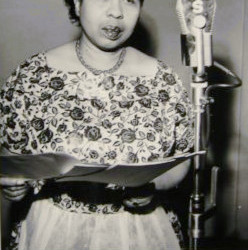
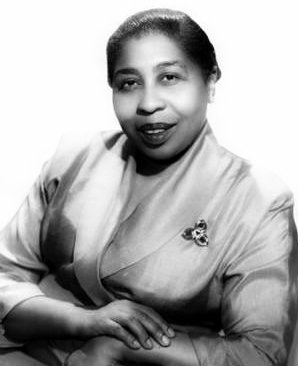



Amanda E. Randolph (September 2, 1896 – August 24, 1967) was an American actress, singer and musician. She was the first African-American performer to star in a regularly scheduled network television show, appearing in DuMont's The Laytons.
Early life
Born in Louisville, Kentucky, Randolph was the daughter of a Methodist minister and a teacher. She had a younger sister, Lillian who also became an actress, and a brother, Steve Gibson, who was the leader of the Rhythm and Blues group, the Five Red Caps. However, new research shows that, although the preceding statement is widely quoted and believed, it isn't true. James "Jay" Price, a member of the Red Caps from 1952-8, says that, while Steve Gibson and Lillian Randolph jokingly called each other "sister" and "brother," they weren't related at all. The story apparently started with the December 31, 1953, article in Jet Magazine, referenced above. It appeared in Major Robinson's gossip column, which carried the most outrageous (and unverified) claims from press agents. Most telling is that, in the 1910 United States Census, Amanda and Lillian's mother was about 50, far too old to have given birth to Steve Gibson on October 12, 1914.
Career
Music
The Randolph family moved frequently. At the age of 14, Randolph began earning extra money playing piano and the organ in Cleveland, Ohio. Around 1919, she moved to Cincinnati, Ohio where she recorded several piano rolls of hot jazz and blues music for the Vocalstyle company of Cincinnati while working as a musician in Ohio's Lyric Theatre. These are the only known rolls recorded by a black female pianist. Randolph did her work for the company under the name Mandy Randolph. She is shown as the performer of "The Yellow Dog Blues", by W. C. Handy in 1919, Vocalstyle roll # 11562. Randolph also wrote music she recorded for the Vocalstyle company; she is shown as both the performer and composer of "I'm Gonna Jazz My Way Right Straight Thru Paradise", and as the co-author of "Cryin' Blues" with H. C. Washington.
Randolph also cut audio recordings, accompanied by Sammie Lewis. A record album was produced in 1996 by Document Records called, Blues & Jazz Obscurities (1923-1931), containing the six duets the pair produced. Still working under the name Mandy Randolph, she recorded "Cootie Crawl" (G11425) on April 30, 1923, and "I Got Another Lovin' Daddy" for Gennett Records.
She was invited to join the Sissle and Blake musical, Shuffle Along, in New York in 1924 and went on to do Lucky Sambo as one of the Three Dixie Songbirds (sharing the bill with its star, Tim Moore). in 1925, she was part of Sissle and Blake's The Chocolate Dandies. Randolph then worked in musicals at New York's Alhambra Theater until 1930, following that with work in Europe and England for a year.
Randolph worked on the vaudeville and burlesque circuits as a comedian and as a singer, noting that Abbott and Costello also got their start the same way. Randolph took a four-year hiatus from show business in 1932; she married and helped her husband run their restaurant in New York called The Clam House, which was a favorite of those in the entertainment industry. She then returned to performing, playing piano at a Greenwich Village club called The Black Cat. She made more records, this time recording for Bluebird Records. The label began in 1932 and was owned by RCA Victor Records. She did the vocals with her own band, billed as Amanda Randolph and her Orchestra. The records were made in New York City on October 8, 1936. On that date, Amanda cut: "Please Don't Talk About My Man" (Bluebird 6615), "Doin' The Suzie-Q" (Bluebird 6615), "Honey, Please Don't Turn Your Back On Me" (Bluebird 6616), "For Sentimental Reasons" (Bluebird 6617), "He May Be Your Man But" (Bluebird 6617), and "I've Got Something In My Eye", (Bluebird 6619-B). She also recorded "After Hours"; some of these songs can be heard on radio station KBRD which also broadcasts on the internet.
Films, radio and television
Randolph's film career began in 1936 with Black Network. She went on to do several Oscar Micheaux films, among them: Swing, Lying Lips and The Notorious Elinor Lee. Broadway roles in The Male Animal and Harlem Cavalcade soon followed. Around the same time, Randolph broke into radio, helped by people she met at The Clam House, who got her a CBS audition. She began working on various radio shows: Young Dr. Malone, Romance of Helen Trent and Big Sister.
She went on to become a regular cast member on Abie's Irish Rose, Kitty Foyle, and Miss Hattie with Ethel Barrymore, where she had the role of Venus. Randolph also appeared on Rudy Vallée's radio show and on Grand Central Station.
She continued working in films until the 1960s, and was one of the first black women to become a comedy favorite on television. Randolph was the first African-American performer to star in a regularly scheduled network television show, appearing in DuMont'sThe Laytons. This short-lived program was on the air two months in 1948.
During the 1948-1949 television season, Randolph starred for about a year in her own daytime musical TV program for DuMont,Amanda, which aired Mon-Fridays from 12noon to 12:15pm ET, making her the first African-American woman with her own show on daytime television. Randolph did not settle in California until 1949, when she earned a role in Sidney Poitier's No Way Out. Even though she was working in New York and her younger sister, Lillian, had been working in Hollywood for some time, newspapers often got the two sisters mixed up, doing a story on Amanda but with a photo of Lillian and vice versa. She then became a regular on the top early black TV show of the decade, Amos 'n' Andy, as Sapphire's mother, Ramona Smith, from 1951 to 1953; she also played the same role for the show's radio version from 1951 to 1954.
Randolph then began working with her sister, Lillian, who played Madame Queen on the radio and television shows. She was the star and titular character in Beulah from 1953 to 1954, assuming the role from Lillian. Randolph also did some work for CBS Radio Workshop in 1956, playing the role of the folk heroine Annie Christmas in The Legend of Annie Christmas.
Randolph had a recurring role as Louise the Maid on CBS's The Danny Thomas Show and appeared in the show's 1967 reunion program, which aired shortly after her death. She guest-starred on the NBC anthology series, The Barbara Stanwyck Show. In 1955, Amanda opened a restaurant in Los Angeles called "Mama's Place", where she did the cooking.
Despite all her film and television work, Randolph found herself slightly short of the requirements for a much-needed Screen Actors Guild pension at the age of 70; both sisters struggled for roles in the late 1930s. A role was written for her to gain eligibility.
Personal life
Randolph married Arthur Sherman in Cincinnati on September 12, 1918, by Rev. James Parkhurst Foote (1878–1949), minister of Zion Methodist Episcopal Church. They later divorced.
Her second marriage was to Harry Hansberry sometime after 1940. Hansberry was the owner of the "Hansberry's Clam House" (aka "Edith's Clam House") at 146 West 133rd Street, New York City's most famous gay speakeasy in Harlem, The couple had two children before separating. They were estranged when Hansberry died of a heart attack in 1961.
Death
Randolph died of a stroke in Duarte, California, on August 24, 1967, aged 70. She is survived by a son, Joseph, and a daughter, Evelyn. She is interred at Forest Lawn Memorial Park in the Hollywood Hills beside her sister, Lillian.
http://wikipedia.thetimetube.com/?q=Amanda+Randolph&lang=en
24 notes
·
View notes
Text
Ratatouille the conceptual musical; online musicals and intermediality from the other direction
When musical theatre creators use intermedial techniques, live onstage performance combined with new media technology is brought before an audience, either in person or by proxy. Intermedial technologies such as projection allow performances to feature pre-recorded material or to include live performance from another location, expanding the depth of the musical by stepping outside the limits of conventional live performance. In 2020, young people on TikTok built a musical from the inside out, in a piece of intermedial theatre unlike any produced by theatre makers for the stage or for deliberate performance. Ratatouille the TikTok musical lacks official direction, staging, script, score, cast, scenography, and pretty much everything else that goes into making theatre. However, the medium of musical theatre, the medium of the TikTok app, and the medium of the meme culture that grew up around it create an intermedial performance that breaks the mould for musical theatre performance of the future.
Throughout the first year of the COVID-19 lockdown, many young people flocked to TikTok, a social media platform in the form of short videos, up to 60 seconds. The amount of creators experiencing the boredom that came out of enforced lockdown with reduced opportunities spawned a massive influx of new memes and entertaining content, and TikTok was the perfect place to explore that. The app allows users to combine their own video with existing sound as well as creating their own, and offers video editing tools such as filters and captions. Once a video is uploaded to TikTok, other users can use the material in their own videos. The audio can be used alone or played over a new video, with the second user being able to include their own sound as well or decide to work only with what another TikTok user has created. They also have the option to duet a video, placing the original material on one side of the screen, and themselves on the other. The audio from the original video can be added to, and many users create interactive videos designed to be duetted, leaving gaps to be filled in their speech, or looking off-screen in the direction of the duetting user. Multiple duets of a song can be used to build harmony, or complete multi-voice videos. Much of the creative culture that developed around TikTok relies on pre-existing knowledge of video or sound, which is then re-created and re-interpreted multiple times by different users.
Before Ratatouille, TikTok creators had already been creating remediated musicals based on existing popular media and recognisable concepts. Alexa Chalnick became popular in August 2020 for creating a song for a musical version of the 2012 movie ‘The Lorax’, and Daniel Mertzlufft, one of the foremost creators of Ratatouille, had previously become famous for Grocery Store: The Musical. In Mertzlufft’s original video, he demonstrates various vocal techniques stereotypically found in an emotional climactic breakup scene taking place in a grocery store. This was duetted by over 500 people adding characters and background to the setting of the grocery store, including shop employees, squeaky wheels on a trolley, and a bystanding can of soup (Chen, 2020). Creating comedy through this extreme attention to detail and over-dramatisation is highly indicative of the type of humour throughout TikTok’s user base, and provides a springboard for the creation of Ratatouille. At the end of of 2020, all of this combined to produce The TikTok Ratatouille Musical, a conceptual musical rather than a concept musical; conceptual in that the musical itself does not exist, but the concept of it is an established musical, recognisable to the many TikTok users who came across it. The overall musical is not determined by a definitive script or performance, but is made up of whatever fragments of the musical make their way to viewers, and the idea of the musical that this creates in each person’s head becomes the musical itself.
The first contribution to the Ratatouille Musical was ‘Ode to Remy’, a 20 second melody made in August 2020 by Emily Jacobsen, praising Remy the rat, the protagonist of the 2007 Disney/Pixar film Ratatouille. In October, another TikTok user, Daniel Mertzlufft, arranged the song in the style of the finale to a Disney musical, especially inspired by “[t]he end of Hunchback [of Notre Dame]” (cited in Alter, 2020). The video’s sound was made digitally using Logic Pro X, and features vocals from Mertzlufft and Cori Jaskier. The video features Mertzlufft dancing and lipsynching to the music, with captions describing the context and intended visuals for the “Big Act II finale”, with “lots of glitter […] Confetti everywhere! Lights going crazy! Remy on a lift flying over the audience!” superimposed over an image of Remy from the movie. This video is the most widely used and referenced song from the musical, featuring in duets proposing scenographic (Ardell, VOID, msfashionbunny, Shoebox Musicals), contextual (Katie, Cleary), and promotional material (Siswick) for the musical. After Mertzlufft’s song gained traction, more creators began composing music for the musical, such as Gabbi Bolt’s ‘Trash is Our Treasure’ and Blake Rouse’s Kitchen Tango duet. People started to duet the videos with proposals for choreography (Simonis), set (Shoebox Musicals) and costume design (Ardell), and even demonstrating what the backstage crew of the musical would be doing at crucial moments (Cook). This carried on developing through the end of 2020, culminating in a concert run by Seaview Productions, featuring performances by many of the creators involved in Ratatouille, as well as Broadway singers and performers such as Tituss Burgess and Andrew Barth Feldman.
TikTok provides an unusual context to explore the concept of intermediality. TikTok as a performance medium consists at its base level of visual and auditory components, created and/or combined by the user. The use of TikTok as a performance platform allows multiple performance types, and facilitates the addition of extra materials, such as a green screen function to provide background images, the combination of pre-existing and simultaneously recorded sound, and the interactive aspect of duetting or otherwise featuring other users’ videos in one’s own.
Ratatouille challenges the notion that liveness in theatre is a necessary component for intermedial performance (Klich & Scheer, 2012, p71). Blending of live, in-person performance and virtual or pre-recorded material is becoming more widely accepted practice throughout all forms of theatre.Robin Nelson suggests that theatre “as a live phenomenon in the here and now” is “being re-qualified contextually as it accommodates an integrated production, recording and storage medium” (2010, pp. 13-14). While the audience doesn’t experience Ratatouille live, the concept of liveness within the musical itself is blurred. When TikTok users add new content to the musical by duetting and adding to existing content, the mixing of existing media in the form of the original video or sound, with new media adds multiple layers of liveness and intermediality. This is evident in Rouse’s ‘Kitchen Tango’ open duet, in which he performs one part, leaving the part of Colette to be sung by other users. Some users, such as Amber, film their reactions to videos within the musical. This contributes to the feeling of liveness in the musical, as viewers of the reaction videos experience the original material alongside the reactor.
Although TikTok as a technological medium is closer to film technology than theatre, Ratatouille is closer to a stage musical than a celluloid musical. The construction and performance style of the musical is almost entirely consciously theatrical. Shoebox Musicals’ demonstration of the visual scenography includes a revolving stage, flown in set pieces, and a cyclorama, lit by miniature stage lights. Similarly, msfashionbunny’s set model features a split set on a revolving stage, demonstrating the use of scale to differentiate the size of the rats and the humans, similar to the use of scale in the set design for Lloyd-Webber’s Cats. Ardell’s costume designs propose using one of the performers’ legs as the rat’s tail, a design choice which would be frowned on in a film musical, where believable realism is the goal, but the suspended disbelief of the theatre fully allows for. Broadway performer Kevin Chamberlin composed Anyone Can Cook, and Karina Simonis choreographed a dance for Rouse’s ‘Kitchen Tango’.
Ratatouille supports Nelson’s argument that “the relations between different media in a multitracked text are ultimately a matter of perception and interpretation” (2010, p13). Not all of the videos contributing to Ratatouille are performances of songs or demonstrations of visuals. Some creators propose a scene, costume, visual effect or theatrical decision simply by describing it. Jack Cleary describes a scene in which food critic Anton Ego eats the ratatouille, proposing this as his first song in the musical. Despite the relative lack of visual or auditory material, these videos are linked with the rest of the musical by using hashtags in the video description, or by using a song from the musical in the background. These are often still included in the accepted canon of the musical, because audiences build a mental representation of the musical themselves based on the pieces provided by other people.
The musical does not need to be seen in a specific order. The purpose of the Ratatouille musical is not to tell the story of Remy, as most viewers are familiar with the plot from the movie. Instead, the purpose is to remediate the concept of the story through recognisable scenes, which the viewer can assemble in their own head. Every consumer has a different experience of the musical. Most viewers will be familiar with the audio of the most popular songs, and some of the more popular videos featuring choreography, visual design, or contextual explanations. Users have some control over which parts of the musical they see and therefore which songs, performances or proposed stylistic choices are included in their mental version of the musical. Some people even began proposing changes to the accepted material content, such as whether or not to replace the lyric “Remy the ratatouille”, as the character is a rat, rather than a ratatouille. Despite not adding material to the musical itself, this internal discourse contributed to the experience of the musical, becoming something of a metanarrative within the overall concept of the musical, as audiences could decide for themselves whether or not to include the song in their interpretation of the musical.
While the purpose of most conventional theatre is to create a production for audience consumption, the medium of TikTok means that the creators of the musical are also audience members, and the creation of the musical is done for the enjoyment of the creators. Although TikTok does provide payment to a few creators with a large number of viewers, many of the contributors only became popular enough to qualify thanks to their role in the development of Ratatouille. Instead, the creation of the musical was borne from a desire to create and share with other TikTok users.
On January 1st, 2021, Seaview Productions staged a performance of the songs from Ratatouille, featuring many of the original creators. The concert was hugely popular, and raised over $2m for The Actors Fund. However, I would argue that the concert marked the end of the Ratatouille musical. Rather than creating a vague framework for audiences to transpose their imagined version of the musical onto, Seaview Productions cast actors and celebrities as the lead characters, providing one definitive image for the musical, rather than allowing audiences to fill in the visuals using context from the film and the recognisable TikTok videos. After the concert, interest in the production of new Ratatouille content dropped almost completely, and the focus of TikTok users shifted elsewhere. Although the intermediality of TikTok allowed the musical to take flight, once Ratatouille entered a new performance medium, it was all over.
The internet musical
The internet allows musical fans to experience musical theatre outside of attending live performances by listening to soundtracks, discussing with other fans, and watching recordings, legal or otherwise. However, the experience of watching a recording of a stage musical is very different from watching an online musical staged for the internet. In 2009, A Very Potter Musical by Starkid, a musical parody of Harry Potter, reached internet fame in fandom spaces after a video recording of a performance was uploaded to YouTube. The musical became extremely popular with fans of Harry Potter, and Starkid produced two sequels, which were also uploaded to YouTube. However, the intermediality and the use of the internet in this case is very different to how it is used in Ratatouille. A Very Potter Musical was produced for live, in-person performance, rather than internet consumption, and the recording is not designed to be the main form of consumption. The use of the internet in the distribution and popularity of A Very Potter Musical largely takes the form of fandom and social media marketing, rather than as the primary vehicle of the musical.
Similarly, the internet musical differs from a celluloid musical because it relies on a framework provided by the internet. The experience of watchingThe Greatest Showman (2017) on Netflix is effectively no different to watching the same musical on DVD, and even in cinemas the material is received in the same way. However, watching AV byte’s 2016 short video ‘The Internet is Down - THE MUSICAL’ relies on the audience accessing it via YouTube. The context of the internet contrasts with the content of the song: a worldwide internet blackout. Watching the video on DVD or a non-internet based format would remove the context and reduce the effectiveness of the piece.
The intermedial use of the internet as a performance vehicle for music and performance has already been established before being necessitated by COVD-19. Choral performances using the internet have been pioneered by choirs and composers such as Eric Whitacre. In Lux Aeterna (2012), Whitacre uses pre-recorded videos and audio tracks of 185 singers in a grid on screen. At 1:00, a singer’s video is expanded during their solo, drawing attention to the performer in a way that is difficult to achieve in live choral performance. In Sing Gently (2020), Whitacre assembles 17572 singers, which would be very difficult to bring together for a live performance, and the use of the internet to facilitate the creation of the video allows Whitacre to use material from performers in 129 countries simultaneously.
The internet is an integral part of modern-day culture, and is used in almost every aspect of life, from education and employment to entertainment and socialisation. It’s natural that theatre and performance finds a new home online, and finds innovative ways to do so, especially under the circumstances of a global lockdown. Using the internet as a platform for musical performance has been a necessary move due to the pandemic, but has also succeeded in making musicals much more accessible for people who would otherwise be obstructed from seeing them (Schiavon, 2020). Since most popular theatre, especially megamusicals and performances featuring popular performers, takes place in major cities such as London’s West End and Broadway in New York, people who live in remote places are less able to attend them. Additionally, people with disabilities, either physical or mental may be prevented from seeing musicals due to added obstructions to travelling, accessing to theatre spaces, and the multisensory experience of a large-scale theatre performance being incredibly overwhelming. Therefore, moving more theatre and performance online opens up opportunities for more people to access musical theatre. While making recorded stage musicals more readily available online is a very positive step, musical theatre makers should fully embrace the available technology to usher in a new generation of online musicals.
The conventions of intermedial theatre are difficult to define, as people at the forefront of theatrical innovation are always finding new ways to integrate new media with performance, meaning that “previously existing medium specific conventions are changed” (Kattenbelt, 2008, p 25). Innovation in technology pushes artistic creators to come up with new ways to use technology in performance and to make performance with technology. When faced with cancellations and boredom, creators turned to newly available technology to do what they do best, and in doing so, redefined the conventions of the musical. As intermedial technology continues to develop, so too, hopefully, will the creation of musical theatre.
Bibliography
Alexa Chalnick [@alexachalnick] (2020); ‘~WHEN WORLDS COLLIDE~’; TikTok; available from: https://vm.tiktok.com/ZMebxyVrK/
Alter, R. (2020); ‘Broadway Is Closed, But Ratatouille the Musical Is Cooking on TikTok’ [online]; Vulture; accessed 09/05/2020; available from: https://www.vulture.com/2020/11/ratatouille-musical-tiktok.html
Amber [@missfionnacharming] (2020); ‘Ranking Songs from the Ratatouille Musical’; TikTok; available from: https://vm.tiktok.com/ZMebvCY5R/
Ardell [@ardellyfoshelly] (2020); ‘Untitled Video’; TikTok; available from: https://vm.tiktok.com/ZMebPtQFF/
Avbyte (2016); ‘The Internet is Down - THE MUSICAL feat. Thomas Sanders’ [online video]; YouTube; accessed on 08/05/2021; available from: https://www.youtube.com/watch?v=Oc30xP-8OH0
Bay-Cheng, S., Kattenbelt, C., Lavender, A., & Nelson, R. (Eds.) (2010); Mapping Intermediality in Performance; Amsterdam; Amsterdam University Press; accessed 10/05/2021; available from: http://www.jstor.org/stable/j.ctt46mwjd
Bolt, G. [@fettuccinefettuqueen] (2020); ‘Trash is Our Treasure’; TikTok; available from: https://vm.tiktok.com/ZMebPByQe/
Chamberlin, K [@chamberlin_kevin]; ‘Anyone Can Cook’; TikTok; available from: https://vm.tiktok.com/ZMebvVfSW/
Chen, T. (2020); ‘This Guy Posted A Silly Video On TikTok And Accidentally Created A Whole Musical Number’; Buzzfeed News; accessed on 08/05/2021; Available from: https://www.buzzfeednews.com/article/tanyachen/epic-tiktok-chain-musical-fighting-in-a-grocery-store
Cleary, J. [@jackattackcleary] (2020); ‘Untitled Video’; TikTok; available from: https://vm.tiktok.com/ZMebPtymc/
Cook, K. [@keegscook] (2020); ‘Stagehands for the Ratatouille Musical standing by.’; TikTok; available from: https://vm.tiktok.com/ZMebPXEWm/
Elleström, L. (2021); The Modalities of Media II: An Expanded Model for Understanding Intermedial Relations in L. Elleström, ed. Beyond Media Borders, Volume 1: Intermedial Relations among Multimodal Media; Palgrave Macmillan; pp 4-84
Eric Whitacre’s Virtual Choir (2010); Eric Whitacre's Virtual Choir - 'Lux Aurumque' [online video]; YouTube; accessed 09/05/2021; available from: https://www.youtube.com/watch?v=D7o7BrlbaDs
Eric Whitacre’s Virtual Choir (2020); Eric Whitacre's Virtual Choir 6: Sing Gently [online video]; YouTube; accessed 09/05/2021; available from: https://www.youtube.com/watch?v=InULYfJHKI0
Jacobsen, E. [@e_jaccs] (2020); ‘Remy – Emily Jacobsen’; TikTok; available from: https://vm.tiktok.com/ZMebPe7SY/
Kattenbelt, C. (2008); ‘Intermediality in Theatre and Performance: Definitions, Perceptions and Medial Relationships’; Cultural Studies Journal of Universitat Jaume I [online]; Vol VI, pp 19-29
Mertzlufft, D. [@danieljmertzlufft] (2020); ‘Grocery Store: A New Musical’; TikTok; available from: https://vm.tiktok.com/ZMebxPbgB/
Mertzlufft, D. [@danieljmertzlufft] (2020); ‘Remy: The Musical OG Song’; TikTok; available from: https://vm.tiktok.com/ZMebPkMv8/
Simonis, K. [@karinasimonis]; ‘Colette’s Kitchen Tango’; TikTok; available from: https://vm.tiktok.com/ZMebQdPKM/
Klich, R., E. Scheer (2012) 'Chapter 4: Liveness and Remediation' in Multimedia Performance, New York: Palgrave Macmillan, pp. 67-87.
Morales, C. (2021); ‘‘Ratatouille,’ the Musical: How This TikTok Creation Came Together’ [online]; The New York Times; accessed on 09/05/2021; available from: https://www.nytimes.com/2020/12/31/theater/ratatouille-tiktok-musical.html
msfashionbunny (2020); ‘Set design for Ratatouille’; TikTok; available from: https://vm.tiktok.com/ZMebPtnaS/
Nelson, R. (2010), ‘Mapping Intermediality in Performance’; Amsterdam University Press, Amsterdam; Available from: ProQuest Ebook Central
Rouse, B. [@blakeyrouse] (2020); ‘Ratatouille Tango’; TikTok; available from: https://vm.tiktok.com/ZMebfotB1/
Rouse, B. [@blakeyrouse] (2020); ‘The Rat’s way of Life’; TikTok; available from: https://vm.tiktok.com/ZMebPYxvD/
Schiavon, I. (2020); ‘BWW Blog: Make Theatre Accessible - A Pandemic Lesson’ [online]; BroadwayWorld; accessed on 10/15/2021; available from: https://www.broadwayworld.com/cleveland/article/BWW-Blog-Make-Theatre-Accessible-A-Pandemic-Lesson-20200814
Shoebox Musicals [@shoeboxmusicals]; ‘’Set design for Ratatouille’; TikTok; available from: https://vm.tiktok.com/ZMebPsSJq/
Siswick, J. [@siswij] (2020); ‘The #RatatouilleMusical marketing department is brainstorming visuals’; TikTok; available from: https://vm.tiktok.com/ZMebxos3v/
Team Starkid (2009); ‘A Very Potter Musical’ [online video playlist]; YouTube; accessed 2012; available from: https://www.youtube.com/watch?v=wmwM_AKeMCk&list=PLC76BE906C9D83A3A
TikTok (2021); ‘TikTok Creator Fund: Your questions answered’ [online]; TikTok; accessed on 10/05/2021; available from: https://newsroom.tiktok.com/en-gb/tiktok-creator-fund-your-questions-answered
Katie [@the bigandsexy70] (2020); ‘Untitled Video’; TikTok; available from: https://vm.tiktok.com/ZMebPsAA4/
Virginás, A (2021); Electronic Screens in Film Diegesis: Modality Modes and Qualifying Aspects of a Formation Enhanced by the Post-digital Era in L. Elleström, ed. Beyond Media Borders,Volume 1: Intermedial Relations among Multimodal Media; Palrave Macmillan; pp 141-169
VOID [@donttouchthevoid] (2020); ‘Here’s the Remy puppet no one asked for’; TikTok; available from: https://vm.tiktok.com/ZMebPqP58/
#theatre#tiktok#ratatouille#ratatousical#theater#broadway#essay#intermediality#academic#musical#musical theatre#musical theater#i got a 76 on this#which is a solid first#can't believe i wrote my final essay on the tiktok ratatouille musical but here we are
0 notes
Photo


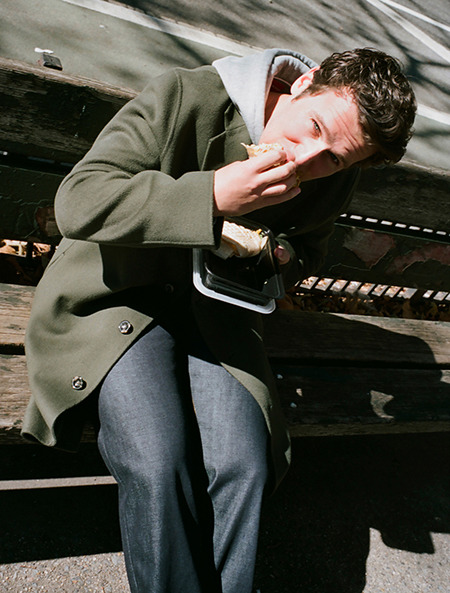
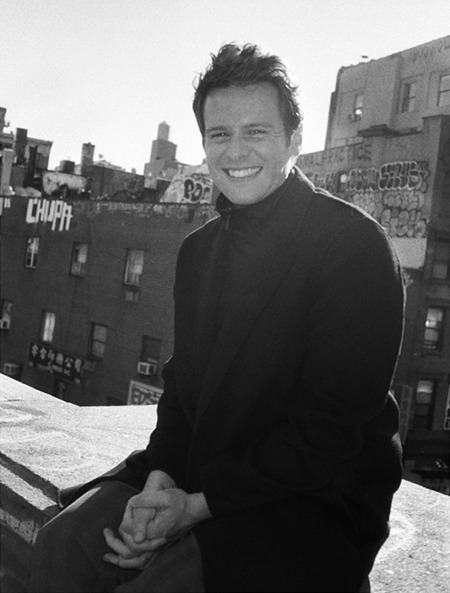


Jonathan Groff Takes On Serial Killers In 'Mindhunter'
As a key cast member in the record-breaking hit musical Hamilton, Jonathan Groff had every right to enjoy the many afterparties he was invited to following the 2016 Tony Awards. But instead, he spent the night after the show picked up the trophy for Best Musical—along with ten others—sleeping in the car on the way back to Pittsburgh, where he was in the middle of shooting the first season of David Fincher’s new series Mindhunter. “The Tonys were crazy because they were on a Sunday night and we were starting at six AM on Monday morning,” he laughs. “We did ‘The Schuyler Sisters’ after Barbra Streisand announced that we won the Tony and I couldn’t go to the party because I had to get into a car. We drove through the night, they dropped me off at my apartment, I changed my clothes and drove out to set, and started. It was so surreal.”
Now streaming on Netflix, Mindhunter revisits the FBI of the late Seventies during the early days of the Behavioral Science Unit, which attempted to use psychology to understand the mindset of serial killers in order to catch them. Groff plays Holden Ford, based loosely on John E. Douglas, who helped pioneer psychology and criminal profiling as investigative tools and wrote the book on which Mindhunter is based. “We email and I can ask him questions, but he lays it all out in his book,” Groff says of Douglas. “He is very frank and forthcoming about everything, including the emotional toll of talking to these killers—and, even more, talking to the families of the victims. He talks about that sort of depression and the emotional intensity of the whole experience. Yes, the show is about interviewing serial killers and the birth of criminal profiling, but it’s also a character piece about the people who started the Behavioral Science Unit and how talking to these people affected them in their real lives.”
The series comes amidst a wave of celebrated crime shows, from True Detective to The Jinx and Making a Murderer, reflecting our age’s fascination with the eternal question of what causes a person to kill another person. In an early episode, Groff’s Holden posits that the turmoil of the era has encouraged a surge of serial killers, although the actor places the show’s murderers on a much longer timeline. “There were always serial killers, like Jack the Ripper, from way long before, but it was almost like the culture was ready to finally look at it then,” he muses. “Coming out of the Fifties and going into the Sixties and Seventies, the culture was finally ready to face the unknown and the FBI finally started to catch up with the times and look at things in less of a black-and-white way and engage with more complicated scenarios. [More recently,] the Las Vegas shooting happened and you go, ‘Fuck, how could someone have done that?’ and that’s the exact question that our show is asking. It’s an endlessly relevant question. There is an unknowable quality to all of it and that is one of the reasons that people keep going back to serial killers, that unfathomable nature of who they are and what they do.”
Groff says he was drawn to project by Fincher, who directed four of the season’s ten episodes and serves as executive producer alongside Charlize Theron. “I would have played any part in anything to work with him,” Groff laughs. “He is so deeply invested and Mindhunter really is his baby. He lived in Pittsburgh with us the entire year and would often show up in the morning even when other people were directing just to be around.”
Fincher is no stranger to serial killers, having directed Seven and Zodiac, although Mindhunter veers away from the typical violence of the genre and vibrates with a subtler kind of tension. The question here is not how or who, but why. “He said it’s all people in rooms talking,” Groff recalls about Fincher’s pitch. “There’s no action sequences, there’s no gore really. They were trying to not romanticize serial killers, but treat it in a more realistic way. The acts themselves are so horrifying and sensational that just talking about them is horrifying. They didn’t want it to be like torture porn, but just something realistic and what really happened.”
Mindhunter shares that rejection of excess with Groff’s last major television project, the HBO show Looking, which followed a group of young gay men in San Francisco and met with a highly polarized response over the course of two seasons and one final film. “I was surprised by the aggressive negativity,” he says. “It wasn’t just that people didn’t like it, it’s that they relished not liking it. Not everyone, but the negative voices were very loud. Our director was gay, a lot of the actors were gay, all our writers were gay—so it hurts a little extra when you feel like you put your heart and soul into it. Ever since Looking, I go in with my heart a little more protected.”
This time, the praise has been nearly universal, with rumors of renewal before the first season even premiered. If the series is not yet a phenomenon on the scale of Hamilton, well what is? “I did Spring Awakening,”—his Broadway début, which earned him his first Tony nomination—“in 2007, and that was like every theater dream I ever had as a kid come true. Then to be in Hamilton, which was such a cultural moment—just to be in the walls of the theater while that was happening was fucking insane.”
A highlight of his Tony-nominated run playing the riotously snide and pompous King George III was performing at the White House. “We did an hourlong selection of the show and there’s the First Lady and the President sitting in the audience,” he recalls. “It was just as Obama was about to leave and at the end he got up impromptu and made a speech and was like, ‘Thank you for teaching me how to say goodbye,’”—quoting a song from the show. “Everyone was crying, it was so amazing.”
Groff left Hamilton to being shooting Mindhunter in April 2016, having finished the musical’s initial run Off Broadway at the Public and seen it through its early months on Broadway. He says he doesn’t regret the decision at all, even if, as a child of theater, he admits he missed singing during his year of filming in Pittsburgh. “I had done [Hamilton] for a year by the time I left, so creatively I felt fulfilled with the experience,” he says. “I left before the Tonys so it was bittersweet in that I would’ve liked to take the rest of the ride with the cast, but Mindhunter was so irresistible for so many reasons that it was a no-brainer. Everyone in Hamilton understood and it was sad to say goodbye, but it ultimately felt like the right decision.”
Mindhunter is now streaming on Netflix.
275 notes
·
View notes
Text
Belushi Review: Showtime’s Look at John Belushi Is Almost Definitive
https://ift.tt/eA8V8J
The world got to know John Belushi’s eyebrows before we got to know the man. They projected his innermost confusion, telegraphed his thought processes, and misdirected his most sincere intentions. Showtime’s heartfelt and intimate documentary, Belushi, opens with clips from the comic icon’s screen test for Saturday Night Live. Armed with just his face, he lets those eyebrows steal the scene. They cajole, caress, and careen across the bottom of his brow, culminating in a series of aerobic stretches with a gymnast’s flair. Belushi didn’t have to crack a joke, he barely had to say a word, and yet showed a world of possibilities within a few inches of cranial space. Belushi really was a lot like his decathlon character in the Little Chocolate Donuts skit. All he needed was some sugar to keep him going. The documentary shows Belushi really was born that way, and didn’t need the extra sweetening.
Too bad he couldn’t keep it up. But we know this from the beginning. The first real scene takes place at the height of Belushi’s fame and adulation. He stole the movie he was just in, Animal House, which was the most successful comedy film of all time at the time. He was on the number one TV show in America. His record The Blues Brothers’ Briefcase of Blues, not even a comedy album, but a labor of love with musician friends he respected and adored, was at the top of the charts, with hit singles doing the same. Director R.J. Cutler (The War Room, The September Issue, Listen to Me Marlon) immediately declares this documentary isn’t about one of America’s favorite performers, it is about the cannibalistic hungers of fame.
“John always had appetites that were completely out of control, for everything, but I didn’t start to worry about him until he was at the Universal Amphitheatre, playing for 7,000 people,” Harold Ramis, who had known Belushi since their improvisational comedy beginnings, says over the soundtrack and applause. “I looked at John on the stage and I thought, ‘He’s on the most popular comedy show of our generation, he was in the most successful comedy film ever, and now he’s onstage fronting an amazing band.’ My first thought was, ‘How great for him.’ My second thought was, ‘Knowing his appetites, I don’t think he’ll survive this.’”
With that, Ramis throws a dark shadow over the rest of the film. Every success the documentary shows from here on has a cloud of doom hanging over it. Belushi was a wild man, bouncing around on the very edge of the most visible stage, both higher than anyone possibly imagined. SNL made overnight stars out of most of its cast. Chevy Chase was plucked out early because, well, he was Chevy Chase and they weren’t. But while former drummer Chase went on to be a matinee draw, Belushi became a rock star.
Belushi’s life has been told before. Watergate journalist Bob Woodward wrote the tawdry 1984 book Wired, which was adapted into a feature film in 1989. The documentary makes ample use of audio clips from Tanner Colby’s 2012 oral history Belushi: A Biography. Belushi’s wife Judith interviewed many of his friends and castmates, like Ramis, Chase, Dan Aykroyd, Jane Curtin, Lorne Michaels, Carrie Fisher, Ivan Reitman, Penny Marshall, and John’s brother Jim Belushi. Judy conducted the interviews in the first few years after Belushi’s death. This gives Belushi an immediacy, but also makes the stories feel older. None of the other interviews are shown as talking heads, except archival footage of Belushi himself.
While the guest voices condense the story, and breathe an even-handed life into the material, Belushi works best when it lets Belushi tell his own version. Some of the most revealing insights come from a series of letters written to Judy, who had been with him ever since Wheaton Community High School. The letters, which open “Dear Jutes,” begin when Belushi is still in an Indiana summer stock company, smoking pot and listening to The Beatles’ Sgt. Pepper’s Lonely Hearts Club Band album, which he writes makes him think of her whenever he hears it, “Especially ‘With a Little Help From My Friends.’” His rendition of Joe Cocker’s adaptation of the song is a late highlight, and Belushi’s letters are interpreted very effectively by Saturday Night Live’s Bill Hader.
The letters illuminate Belushi’s passions while humanizing the larger-than-life performer. Home movie footage succeeds in showing him trying to find an elusive normalcy in real life. The letters offset the seemingly effortless rise of the comedian with the inner turmoil that fed it. Belushi comes off as obsessed with success but terrified of fame. A late letter reveals Belushi was afraid he reached a point of no return. Some of the letters are funny, others insecure, still others come off as despondent.
One of the most unexpected revelations about Belushi is how he felt like an outsider growing up, and was embarrassed by his Albanian immigrant background. One wouldn’t think Belushi might be embarrassed by anything. “We all wanted to be American,” his brother Jim Belushi explains. John, who was expected to work in his father’s restaurant, instead put it to work for him, inspiring his Pete Dionasopoulos of the Olympia Café character in the “Cheeseburger, cheeseburger” sketches.
Much of Belushi’s story is brought to life by the animated sequences from Robert Valley. These are particularly effective when showing Belushi during his high school years drumming with a band called the Ravens, and illustrating his time with the improv group he founded, The West Compass Players, which led to his joining Chicago’s Second City troupe. His rise is spectacularly fun to hear, and the animation makes up for lost footage.
The film also gets into his many contradictions. Belushi is drawn losing himself in the albums of comics like Jonathan Winters and Bob Newhart. But when he is asked, during his Second City period, his opinion on Lou Costello, Belushi says “Nope, don’t like him.” John wanted to create something new. The film also shows how much spontaneity played into Belushi’s comedy. He’d only seen the samurai movie with Toshiro Mifune on TV the night before he auditioned for Saturday Night Live.
Belushi was flown from Chicago to New York to officiate over Lemmings, National Lampoon’s Off-Broadway spoof of Woodstock. He stole the show with his impersonation of Joe Cocker. Lorne Michaels saw Saturday Night Live as a show which would be an “upheaval” for network television. Belushi said he hated television during his interview, but told Michaels he would deign to appear on the show. He’d already auditioned for a rival series called “Saturday Night,” which was going to be headlined by sports announcer Howard Cosell.
The documentary expertly weaves the double-edged sword of celebrity. Belushi chafed at being recognized on the street as “that Bee guy” from their bumble-bee sketches, but his performances, many of them exercises in extreme physical comedy, struck a nerve with audiences. Belushi lets clips strike at the audience to back it up. Michaels compares Belushi to Jackie Gleason’s Ralph Kramden from The Honeymooners, because he brought a blue-collar vibe. On SNL, Belushi is remembered as being very competitive, distracted by the success of Chevy Chase, and dismissive of the women writers and performers. Once Chase left, Michaels says “the thing that John most hoped for, that he would be the alpha male, had now happened.”
The documentary is at its most exciting when it shows clips. From the early Lemmings stage show, through Saturday Night Live, Belushi highlights the anarchy Belushi brought to the stage. It could easily slip into be a “best of” clip show, featuring his memorable characters Jake Blues and the Samurai, or his ruthless spoof of Elizabeth Taylor choking on a chicken bone, giving herself the Heimlich maneuver and returning to the chicken. But instead informs Belushi’s motivations. Cutler consistently finds perfect clips to illustrate how Belushi’s individuality drove him to seemingly unimaginable heights. The onscreen examples justify the star quality which put him on the cover of Newsweek and Rolling Stone. We get the sense of how Belushi helped change American culture and comedy, in the same league as Lenny Bruce, Richard Pryor, Lily Tomlin, and George Carlin. But while scaling the dizzying heights, the movie never loses its sense of doom.
Belushi’s spiral into addiction is covered at length. In the second season of SNL, Belushi got injured doing a pratfall and was prescribed painkillers. When the prescription ran out, he turned to the street for hard drugs. Later in his career, Belushi would hire President Nixon’s personal bodyguard to keep him away from bad influences, but on his rise up, many of his colleagues cut him a lot of slack. “He was testing all his boundaries at that point,” The Blues Brothers director John Landis explains, before excusing Belushi: “I don’t think we lost more than four or five days of shooting because of the drugs.”
Belushi got clean for a year, living Martha’s Vineyard. Carrie Fisher, however, says in an interview that by skipping rehab, Belushi never dealt with sobriety’s most challenging aspects: day to day life can be boring, and the comic star didn’t have the coping mechanism to deal with feelings the drugs were covering up. Cutler’s documentary is moving, offering a look into the soul of the man who embodied the “animal” found in every college fraternity, Bluto in Animal House. The documentary deftly explores Belushi’s attempts to make the beast noble, taking his acting seriously in smaller films like Old Boyfriends, Continental Divide, and trying to break out of the audience’s preconceptions with his last film Neighbors.
Cutler finds Belushi, the performer, but doesn’t quite catch John as a person as Belushi incrementally shifts its focus from his art to his drug binges. Belushi can’t fully celebrate Belushi, because everyone watching knows the ending. In March of 1982, Belushi sequestered himself at the Chateau Marmont in Los Angeles in order to finish “Noble Rot,” a screenplay he was writing with Don Novello. Here the film very succinctly and poignantly captures the love people felt for the man, Belushi. Aykroyd, who said he fell in love with Belushi the moment they met, still bears deep wounds.
“He was sad and defeated,” Aykroyd remembers about his last conversation. “I thought I’ll finish this page, this paragraph and get out there. I didn’t get to him in time. I carry that with me forever.” Belushi’s long-time blues and soul brother thought he had a solution. “I told him I was writing something great for us,” we hear Aykroyd say in the film. “I was writing Ghostbusters.” While the documentary gives this revelation a sheen of hopeful might-have-beens, it really only underscores how that would be a mistake assumption. Everything about the documentary says a successful film might only have slowed the same inevitable ending.
For all the archival footage found in Belushi, one particular short film broadcast on Saturday Night Live is sadly not featured, except for a few stills in one of the quicker montages. “Don’t Look Back in Anger” shows John, as an old man, walking through a cemetery and reminiscing about his old friends on SNL. They’re all dead in the film, Belushi is the last survivor. Why? Because he is a dancer. This may have been how he saw himself, and as his audience most wanted to see him. But for all the missed promise it may have subverted, the skit fits with Belushi’s larger picture. John Belushi is dancing through a graveyard, happily. The film is a wake, of sorts. But the dance is how Belushi ultimately moved through life, with a dancer’s grace which defied the body held down by strong appetites. Belushi would have been a more satisfying film if it took smaller bites.
cnx.cmd.push(function() { cnx({ playerId: "106e33c0-3911-473c-b599-b1426db57530", }).render("0270c398a82f44f49c23c16122516796"); });
Belushi airs Sunday, Nov. 22, at 9 p.m., on Showtime.
The post Belushi Review: Showtime’s Look at John Belushi Is Almost Definitive appeared first on Den of Geek.
from Den of Geek https://ift.tt/3kQ6a3g
0 notes
Text
Below is a list of movies opening in the U.S. from September to December, organized chronologically by release date.
Among the movies of interest to theater lovers: Finn Wittrock (Death of A Salesman, Glass Menagerie) portrays Judy Garland’s fifth husband in “Judy,” a movie about her that bears great resemblance to a play that was on Broadway. Cynthia Erivo and Leslie Odom Jr. (Tony winners for The Color Purple and Hamilton, respectively) star in “Harriet,” about Harriet Tubman. Pulitzer Prize winning playwright Tracy Letts adapts a novel for the screen. And, Heaven help us, both Dame Judi Dench and Sir Ian McKellen (as Gus The Theater Cat) in Cats, the movie version of the Broadway musical.
Cynthia Erivo as Harriet Tubman
Dame Judy dench in Cats
Renee Zellweger and Finn Wittrock and Judy Garland and her fifth husband in “Judy”
Leslie Odom Jr in Harriet
Meryl Streep in Little Women
Sir Ian McKellen as Gus the Theater cat in Cats
(Below, an asterisk is placed next to names of movie cast members that theatergoers can legitimately claim as legitimate stage artists now or at least originally. For example, Willem Dafoe, a familiar face on screen who is appearing is appearing in two high-profile movies this Fall, is a founding member of the experimental theater company The Wooster Group.)
SEPTEMBER
September 2
youtube
Untouchable
Hulu
Directed by: Ursula McFarlane
Cast: Rosanna Arquette, Ronan Farrow, Paz de la Huerta
A documentary about Harvey Weinstein and the #MeToo movement.
September 6
youtube
It: Chapter 2
Directed by: Andrés Muschietti
Cast: Bill Hader, Jessica Chastain, James McAvoy, Finn Wolfhard, Sophia Lillis, Bill Skarsgard
Twenty-seven years after the Losers Club’s terrifying encounter with Derry’s most notorious clown, they receive a phone call that brings them all back together again.
Also:
Blink of an Eye
Ms. Purple
September 13
youtube
The Goldfinch
Directed by: John Crowley
Cast: Ansel Elgort, Finn Wolfhard, Nicole Kidman, Ashleigh Cummings, *Jeffrey Wright, Aneurin Bernard, Sarah Paulson, Luke Wilson
Based on Donna Tart’s Pulitzer Prize-winning 2014 novel from 2014 about one of the only survivors of a bombing at the Metropolitan Museum of Art, as he struggles to let go of his one connection to that day: a painting of a tiny bird, otherwise known as The Goldfinch.
youtube
Haunt
Directed by: Scott Beck and Bryan Woods
Cast: Katie Stevens, Will Brittain, Lauryn Alisa McClain
On Halloween, a group of friends discover a haunted house that claims to create thrills based on real fears.
youtube
Hustlers
Directed by: Lorene Scafaria
Cast: Jennifer Lopez, Cardi B, Constance Wu, Lizzo, Keke Palmer, Julia Stiles, Lili Reinhart
Inspired by a 2015 New York Magazine article about a group of strippers stealing from their rich Wall Street clients during the financial crisis.
Also (bear in mind it’s Friday the 13th)
Depraved
Freaks
Monos
Moonlight Sonata
September 20
youtube
Ad Astra
Directed by: James Gray
Cast: Brad Pitt, Liv Tyler, Tommy Lee Jones, Ruth Negga
Astronaut Roy McBride (Pitt) travels to the outer edge of our solar system on a dangerous mission to find his father (Tommy Lee Jones) who disappeared decades earlier, and may hold the key to a secret that threatens our very existence.
youtube
Downton Abbey
Release date: September 20
Directed by: Michael Engler
Cast: *Maggie Smith, Michelle Dockery, Laura Carmichael, Hugh Bonneville, Jim Carter, Joanna Froggat, Matthew Goode, *Elizabeth McGovern
The TV series made into a movie: It’s 1927, and Downton Abbey is about to receive some very special guests: King George V and Queen Mary.
youtube
Rambo: Last Blood
Directed by: Adrian Grunberg
Cast: Sylvester Stallone, Paz Vega, Sergio Peris-Mencheta, Adriana Barraza, Yvette Monreal
The fifth Rambo installment; this time the daughter of a friend is kidnapped by a Mexican cartel
Between Two Ferns: The Movie
Netflix
Directed by: Scott Aukerman
Cast: Zach Galifanakis, Lauren Lapkus, Ginger Gonzaga
A movie based on Zach Galifanakis’ cult parody talk show. Galifanakis must hit the road to defend his reputation as the premier celebrity interviewer of our time.
Also:
Corporate Animals
Diego Maradona
Where’s My Roy Cohn?
September 27
youtube
Judy
Directed by: Rupert Goold
Cast: Renee Zellweger, Rufus Sewell, Finn Wittrock, Jessie Buckley
The last year of Judy Garland’s life, largely based on Peter Quilter’s play End of the Rainbow. During a five-week run in London she reflects on her rise to stardom, and fall in love with Mickey Deans (Wittrock) the man who became her fifth husband.
youtube
The Report
Directed by: Scott Z. Burns
Cast Adam Driver, Annette Bening, Jon Hamm, Matthew Rhys, Corey Stoll
Based on a true story, this political thriller follows Senate staffer Daniel Jones (Driver) as he leads an investigation in the CIA’s Detention and Interrogation Program, which engaged in “enhanced interrogation techniques” after 9/11.
Also:
The Day Shall Come
The Death of Dick Long
Extra Ordinary
The Sound of Silence
OCTOBER
October 4
youtube
Joker
Directed by: Todd Phillips
Cast: Joaquin Phoenix, Robert De Niro. Zazie Beetz
The origin story of the Batman villain, who started as a lonely, failed stand-up comedian.
The Woman in the Window
Directed by: Joe Wright
Cast: Amy Adams, *Gary Oldman, Julianne Moore, Anthony Mackie, Brian Tyree Henry
Adapted by Tracy Letts from the best-selling novel by A.J. Finn, the movie stars Adams as an agoraphobic child psychologist who spends her days spying on the perfect family next door. But then she witnesses a crime…
youtube
Pain and Glory
Directed by: Pedro Almodovar
Cast: Antonio Banderas, Penelope Cruz
Banderas won Best Actor at the Cannes Film Festival for his role as a film director in the middle of a creative crisis
youtube
The Current War
Directed by: Alfonso Gomez-Rejon
Cast: Benedict Cumberbatch, *Michael Shannon, Nicholas Hoult, *Tom Holland, Katherine Waterston
Inventors Thomas Edison (Cumberbatch) and George Westinghouse (Shannon) race to complete rival electrical systems that will change modern life.
youtube
Lucy in the Sky
Directed by: Noah Hawley
Cast: Natalie Portman, Jon Hamm, Dan Stevens, Zazie Bettz, *Ellen Burstyn
Based on a true story, Portman stars as an astronaut who kidnaps his ex-boyfriend’s new girlfriend and drives from Houston to Orlando wearing an adult diaper. After a long mission, Lucy returns to Earth only to find her connection with her family — and reality — slipping away.
Also:
Wrinkles the Clown
October 11
youtube
Gemini Man
Directed by: Ang Lee
Cast: Will Smith, Mary Elizabeth Winstead, Clive Owen, Benedict Wong
A former government assassin is targeted by his younger, more agile clone, able to predict his every thought and movement.
Parasite
Directed by: Bong Joon-ho
Cast Song Kang-ho, Lee Sun-kyun, Cho Yeo-jeong, Choi Woo-shik, Park So-dam
The first Korean movie to win the Palme D’Or at the Cannes Film Festival earlier this year, it is a pitch-black modern fairytale the follows the wealthy Park family, and the much-poorer Kim clan.
Also:
Jexi
The Dead Center (Limited)
High Strung Free Dance (Limited)
October 18
The Lighthouse
Directed by: Robert Eggers
Cast Robert Pattinson, *Willem Dafoe
Two New England lighthouse keepers slowly lose their sanity.
Zombieland 2: Double Tap
Directed by: Ruben Fleischer
Cast: Woody Harrelson, Jesse Eisenberg, Emma Stone, Abigail Breslin, Bill Murray, Rosario Dawson, Zoey Deutch, Luke Wilson
Ten years after the original movie, the characters reconnoitre at the White House, and head back on the road, meeting new survivors and enemies on the way. When he’s not acting in movies, Jesse Eisenberg has been busy writing plays Off-Broadway.
Maleficent 2: Mistress of Evil
Directed by: Joachim Ranning
Cast:Angelina Jolie, Elle Fanning, Michelle Pfeiffer, Sam Reilly
Set several years after the first movie, Maleficent (Jolie) is living in peace when Aurora (Fanning) and Prince Phillip’s (Harris Dickinson) engagement throws everything into turmoil.
youtube
The Addams Family
Directed by: Conrad Vernon, Greg Tiernan
Cast: Charlize Theron, Chloë Grace Moretz, Oscar Isaac, Finn Wolfhard, Snoop Dog, Allison Janney, Bette Midler
In this animated film, the family does battle with a reality show host.
youtube
Jojo Rabbit
Directed by: Taika Waititi
Cast Taiki Waititi, Roman Griffin Davis, Thomasin McKenzie, Rebel Wilson, Stephen Merchant, Alfie Allen, Sam Rockwell, Scarlett Johansson
Based on the book Caging Skies by Christine Leunen, set during World War II in Germany, Griffin Davis is Jojo “Rabbit” Betzler, who discovers that his mother (Johansson) is hiding a Jewish girl in their attic. Jojo must confront his Nazi beliefs, with the help of his imaginary friend, a goofy version of the Fuhrer.
Also: Greener Grass
October 25
Black and Blue
Directed by: Deon Taylor
Cast Naomie Harris, Tyrese Gibson, Frank Grillo
When rookie police officer Alicia West (Harris) accidentally records corrupt cops committing a crime on her body camera, she turns to her only possible ally, Milo “Mouse” Jackson (Gibson), to help her make sure they face justice.
The Last Full Measure
Directed by: Todd Robinson
Cast Sebastian Stan, *Christopher Plummer, Ed Harris, William Hurt, Samuel L. Jackson, Jeremy Irvine, Alison Sudol
Based on a true story, Sebastian Stan plays investigator Scott Huffman, who signs on to help Vietnam veterans lobby for their comrade-in-arms to get a Congressional Medal of Honor after he gave his life saving them.
Also:
Countdown
Frankie
The Kill Team
Synonyms
NOVEMBER
November 1
youtube
Motherless Brooklyn
Release date: November 1
Directed by: Edward Norton
Cast Edward Norton, *Willem Dafoe, Gugu Mbatha-Raw, Leslie Mann, Bobby Cannavale, Bruce Willis, Alec Baldwin, Fisher Stevens, *Cherry Jones
Based on Jonathan Lethem’s novel, this detective thriller stars Norton as a private eye with Tourette syndrome, who finds himself embroiled in a conspiracy involving Alec Baldwin.
youtube
Harriet
Release date: November 1
Directed by: Kasi Lemmons
Cast: *Cynthia Erivo, Janelle Monae, Joe Alwyn,* Leslie Odom Jr.
Erivo as Harriet Tubman
Also:
Arctic Dogs
Terminator: Dark Fate
Burden
Waves
November 8
Doctor Sleep
Last Christmas
Midway
Playing with Fire
Honey Boy
November 15
youtube
Ford v. Ferrari
Directed by: James Mangold
Cast: Matt Damon, Christian Bale
A British driver named Ken Miles (Christian Bale) and an engineer named Carroll Shelby (Matt Damon) to design something to compete against the Europeans
Also:
All Rise
Charlie’s Angels
The Good Liar
The Lodge
November 22
21 Bridges
A Beautiful Day in the Neighborhood
Frozen II
Dark Waters
November 27 (Thanksgiving)
Knives Out
Queen & Slim
DECEMBER
December 6
The Aeronauts
Brahms: The Boy II
Playmobil: The Movie
Little Joe
Portrait of a Lady on Fire
December 13
Black Christmas
Jumanji: The Next Level
Cunningham
A Hidden Life
Shaun the Sheep Movie: Farmageddon
Uncut Gems
December 20
youtube
Star Wars: The Rise of Skywalker
Directed by J.J. Abrams
Cast: Adam Driver as Kylo Ren, Daisy Ridley, Domhnall Gleeson, Keri Russell, Mark Hamill, Oscar Isaac, Billie Lourd, Lupita Nyong’o, Carrie Fisher (!)
Theatergoers note: Adam Driver and Keri Russell were the co-stars of Burn This on Broadway last season.
youtube
Bombshell
Cast: Charlize Theron, Nicole Kidman, Margot Robbie, *John Lithgow, Kate McKinnon, *Alison Janney
The story of Fox News head Roger Ailes’ sexual harassment of his female employees.
youtube
Cats
Cast: *James Corden as Bustopher Jones, *Judi Dench as Old Deuteronomy, Jason Derulo as Rum Tum Tugger, Idris Elba as Macavity, Jennifer Hudson as Grizabella[, *Ian McKellen as Gus the Theatre Cat, Taylor Swift as Bombalurina, Rebel Wilson as Jennyanydots et al
The movie version of the long-running Broadway musical.
Also:
Superintelligence
December 25 (Christmas)
youtube
Little Women
Directed by Greta Gerwig
Cast: Saoirse Ronan, Emma Watson, Florence Pugh, Eliza Scanlen, Timothée Chalamet, Laura Dern and *Meryl Streep
The eighth feature film adaptation of the 1868 novel by Louisa May Alcott.
Also:
1917
Spies in Disguise
Just Mercy
December 27
Clemency
Fall 2019 Movie Preview for Theater Lovers Below is a list of movies opening in the U.S. from September to December, organized chronologically by release date.
0 notes